- Fiore at 100: Maine Observed
Maine Art Gallery, Wiscasset, ME • maineartgallerywiscasset.org • Through August 24, 2025
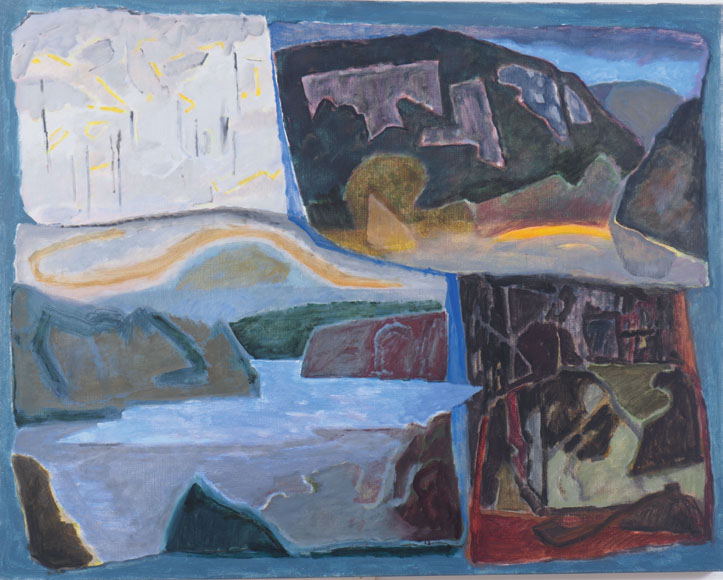
Joseph Fiore, Megunticook, 1987, oil on canvas, 38 x 48″. Courtesy Maine Farmland Trust and Maine Art Gallery. While at Black Mountain College in the 1950s, as student and then teacher, painter Joseph Fiore (1925–2008) worked with, and alongside, the likes of Josef Albers, Willem De Kooning and Ilya Bolotowsky. As art scholar Mary Emma Harris has noted, there was an expectation at the college to be abstract, a directive Fiore respected but also rebelled against over a creative lifetime.
Curated by watercolorist David Dewey, a former Fiore student, this exhibition highlights the painter’s transition from abstraction to representation—and back again, often overlapping. Arriving in Maine with his family in 1959, the painter shifted to a realist mode. As it has for so many artists before and after him, the landscape cast an irresistible spell.
Fiore wasted little time responding to the tidal reaches and rock-bound edge of the Gulf of Maine, setting up his easel in front of various coastal prospects. He also looked inland, to orchards, hay fields and a view of distant Mount Katahdin. As art historian Susan Danly observed in the monograph Nature Observed: The Landscapes of Joseph Fiore, “The big theatre of nature rather than the indoor drama of the art world held Fiore’s attention and affection.”
Later in life, Fiore embraced his earlier abstract leanings. “Conflating time, observation, and memory,” states arts writer Suzette McAvoy in the exhibition catalogue, “these late works, like the sonorous Sounds of the Mountain, 1985, and Megunticook, 1987, reflect on the symbiotic relationship between the earth and humankind.” The latter painting offers four landscapes in one, riffing on the mid-coast Maine lake and mountain in different seasons.
“It is like a journey laid out in visual shorthand,” Danly has written.Fiore was an active member of the nonprofit Maine Art Gallery in the 1960s and ‘70s. In celebration of the hundredth year of his birth, the gallery is partnering with Maine Farmland Trust, which was gifted a significant portion of his estate in honor of its work to preserve Maine farms. Fiore at 100: Maine Observed is an overdue—and most welcome—survey, making a powerful case for revisiting and admiring anew this artist’s remarkable work.
— Carl Little
- MosaicArt Collective
Mosaic Art Collective, Manchester, NH • mosaicartcollective.com • Through June 27, 2025

Donna Catanzaro, Relationships, mixed media, 3 x 12 x 6″. Courtesy of the artist. Liz Pieroni moved back to southern New Hampshire during the pandemic. As she struggled to find studio space and a gallery that suited her needs, she realized others must be having the same problem. Pieroni began to reach out to fellow artists and makers in the community, and in 2022, Mosaic Art Collective was founded.
Mosaic consists of studio spaces for four artists and one gallerist, Amy Regan. Regan runs her boutique gallery See Saw Art out of the Collective. Mosaic runs their own storefront gallery space where they show monthly exhibitions around centralized themes. Most of these shows are open call. “I’d say the majority of the experience is based on building community around art,” said Pieroni. “There’s a lot of people that need to be in and around communities that make art.”
On view this spring, Impressions is themed around the concept of printmaking. The Collective’s first genre show, this exhibition seeks to expand the boundaries of what we call printmaking. Traditional methods such as lithograph, monoprint and screen printing will be on display as well as non-traditional methods including photography and 3D printed art as a form of sculptural printmaking. There will be an opening reception for this show on May 10. “You can expect lots of people that are wanting to talk to you, wanting to learn more about what you’re making, your process, it’s just a really great way of meeting new people.”
Community building is at the center of what the Mosaic Art Collective does. And never has this been more important. With federal funding cuts affecting the New Hampshire State Council on the Arts, many artists in the region will be feeling the loss of grants and support. “As culture keepers and history record keepers, which is what all artists are, I think it’s really important for our society to have this understanding of how important it is to show up for these events and show up for your friends who make art, even if it’s their first show or it’s their 70th show, to show up at these openings and take a chance and find local art galleries.”
— Autumn Duke
- Nora Valdez: ESPERANDO/WAITING
Boston Sculptors Gallery, Boston, MA • bostonsculptors.com • Through June 8, 2025
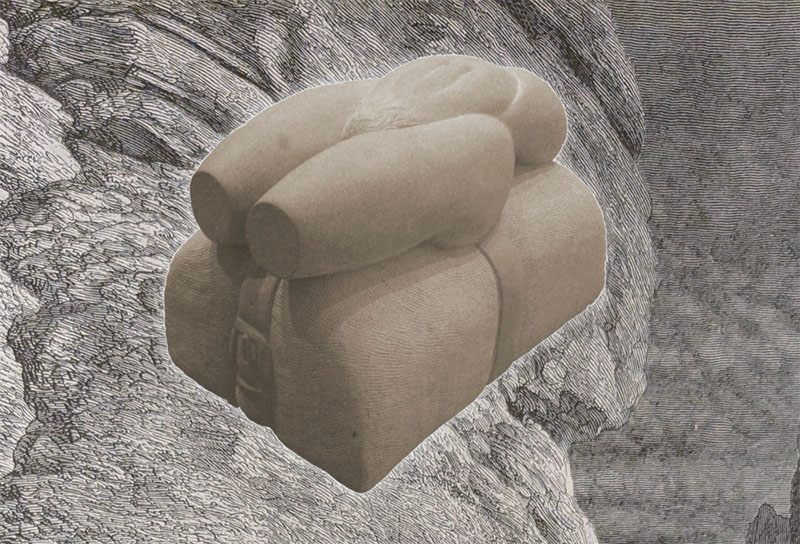
Package, Indiana Limestone , 36 x 21 x 20″. Courtesy of the artist. ESPERANDO/WAITING, Nora Valdez’ exhibition at Boston Sculptors Gallery leads the viewer on a journey that seems endless. The artist writes, “I realize I feel I’m always waiting . . . but for what? What exactly is it that I’m waiting for?” Originally from Argentina, Valdez has always felt suspended between two worlds.
Package, a particularly powerful installation, is an 8 x 10 foot drawing on two corners of a wall with a limestone sculpture of a woman’s torso atop a belted bundle. The torso is a metaphor for the artist’s self that she carries from place to place. The surrounding over life-sized drawings in black pastel pencil on the corner walls are figures in waiting—unwitting witnesses to the passage of Package—as anonymous as immigrants who can never be sure how they will be treated. A grey granite column to the right with a drawing of a face entitled My mother’s words includes words in Spanish, “Te espere y nunca regresaste.” “I wait for you, and you never come.”
On an opposite wall is a grid of ten ink drawings set in white hand-carved wood frames from Cuzco, Peru. The series, Esperando/Waiting, is drawn directly onto pages of an old book of Gustave Dore etchings. There is a powerful dialogue between the journeying figures and the delicately etched scenes, as if alluding to the continuity of the human journey yet not bound by time.
In addition to the installation and drawings, there are several limestone carvings of figures huddled together as if seeking protection, and a circle of child-sized white chairs with hands holding each other. Another wall shows photographs of Valdez’ numerous public art sculptures.
This sense of “waiting” is something that is shared amongst many people today. Valdez’s ability to infuse these drawings and sculptures with a sense of life passage is uncanny. Such work can only emanate from deeply held questions. This is a rare, emotionally full exhibition, one that gives voice to the questions that many of us live with daily. Perhaps there is comfort in seeing a reflection of shared feelings expressed in a most sensitive manner.
—B. Amore
- Michael Beatty: Fabrications
Iris and B. Gerald Cantor Art Gallery, College of the Holy Cross, Worcester, MA • holycross.edu • Through April 1, 2025

Michael Beatty, Core #6, 2011, birch plywood with milk paint and wax, 13¼ x 10 x 5¾”. Courtesy of the artist. Professor Emeritus Michael Beatty considers himself “a maker of objects.” Thus, Fabrications is just the right name for this exhibition, which combines his “sculptures” alongside drawings, prints, and study models. The engaging display spotlights Beatty’s playfully philosophical output, from 1992 to the present.
In the Visual Arts Department at Holy Cross, Beatty taught sculpture and 3-D design for twenty-five years, before retiring in 2023. His works are an amalgam of techniques and materials, influences and themes. For Beatty, an interdisciplinary crafts maker, process is key. He’ll start with a doodle or a sketch, use technology-assisted methods to visualize his ideas, and give them shape using wood, steel, and 3-D printing.
Beatty considers his work “drawings in space.” In Twist/Hold, a narrow ribbon of bent laminated wood supported by skinny steel “girders” looks like a minimalist roller coaster. It’s graceful and soothing. In a trio of drawings, Beatty connects a strong geometric line with a curvilinear shape, thus uniting rigid and flowing forms. Beatty gives this approach a second life—in 3D—with two small sculptures of welded steel and laminated wood.
Three small objects from Beatty’s birch plywood “Core” series, which is inspired by CT scans, resemble botanical shapes, and thus link body and nature. In Plato’s Chalkboard, a series of monotypes produced in collaboration with printmaker James Stroud of Center Street Studio, Beatty calls forth floating, wire-like objects that visualize the theories about three-dimensional shapes that Plato posited—without illustrations.
Another series, “Blips,” is comprised of small, lathe-turned bulbous objects covered in graphite. Inspired by cosmic images from the Hubble telescope, these playful extensions of Beatty’s fundamental forms are arrayed in out-of-the-way spaces throughout the show.
A special highlight of the exhibition, a mock-up of Beatty’s studio, unveils his iterative and experimental process of making. It’s filled with sketches, maquettes, prototypes, and works in progress—all in conversation with each other.
The fabrications dreamed up by Beatty invoke feelings of wonder. “Beatty’s abstract works,” says gallery director Lauren Szumita, “are inspired by very real things—in nature, architecture, space, and the human form. There are traces of something familiar that are just out of reach. Beatty wants us to be comfortable with not finding out the answers, but to think about our experience.”
— Jack Curtis
- Four Related Visions: David M. Carroll, Laurette Carroll,Sean Carroll, Riana Frost
Two Villages Art Society, Hopkinton, NH • twovillagesart.org • Through April 19, 2025

David M. Carroll, Russian Avant Garde inspired work, Untitled. Photo: Laurie D. Morrissey. It is rare for an artist well-known for a distinctive kind of work and subject matter to make a major artistic shift late in his career. David M. Carroll, a MacArthur “genius grant” recipient, artist, illustrator, and author, recently moved into Cubist-influenced art and surrealism. His latest work is abstract, non-objective art inspired by the Russian Avant-Garde movement. The current exhibition at Two Villages Art Society features some of this new work as well as the natural history paintings for which he is known. The latter work will be familiar to readers of Carroll’s acclaimed books on the wildlife of the wetlands (including The Year of the Turtle, Trout Reflections, and Swampwalker’s Journal).
In Four Related Visions, Carroll’s work is displayed alongside that of family members. The exhibition is grounded in their family bond and the natural surroundings of their home in rural New Hampshire. The woods, wetlands, and semi-wild gardens surrounding their 250-year-old home figure in the work of these lifelong artists.
David M. Carroll’s wife, Laurette Carroll, paints in oils, acrylics, watercolor and paste, often using mixed media and integrating drawing and collage elements into her paintings. Her approaches range from naturalistic to impressionistic and abstract. She paints mainly from nature and often incorporates writing from her garden journals into her paintings of flowers and garden landscapes. The couple’s son, Sean, who makes his living restoring old houses, is a plein air painter focusing on landscapes and fishing scenes in Vermont, New Hampshire, and Maine. Daughter Riana Frost paints moose, deer, and other animals on wild turkey feathers she obtains from licensed hunters. She paints in acrylic with a very fine brush on the challenging surface of the feather.
In addition to original paintings, drawings, sculptures, and painted clay vessels, the gallery will have prints and books for sale. There will also be an opening reception with the artists March 22 from 12-2 p.m.
Two Villages Art Society’s gallery is a small brick building on the main street of Contoocook, a village in the town of Hopkinton, and is in walking distance to a river, historic covered bridge, small shops, and restaurants.
— Laurie D. Morrissey
- From Haiti to Vermont
South Burlington Library, Burlington, VT • southburlingtonlibrary.org • Through April 2025

The Village Band, 2022, acrylic on canvas, 71 x 61″. Courtesy of the artist. Most artists are motivated by an inner drive to create but few are as productive as Vermont artist Pievy Polyte. Starting in December 2024 and extending through the end of April 2025, Polyte’s colorful, often joyful paintings of his Haitian homeland’s lush landscape and hard-working people are on view in three separate but overlapping exhibitions.
Polyte is a natural born collaborator, and his exhibitions are in venues supported by local businesses and organizations. A month after he installed his eyepopping paintings on the walls of the popular, renovated, Maltex mill building turned office complex in Burlington’s trendy South End Arts District, he was hanging a selection of figurative and landscape paintings at The Skinny Pancake, a Burlington waterfront restaurant, and in February the South Burlington Library hosted From Haiti to Vermont, its second solo exhibition of the prolific painter’s work. His first exhibition at the library in 2024 garnered so much positive attention that the University of Vermont acquired two large scale paintings from this show. Stylistically, Polyte employs the flattening of forms and compressed perspective of folk art, yet he injects a more sophisticated acknowledgement of cubism’s influence in his compositions. His landscapes recall French post-impressionist Henri Rousseau (1844–1910) in their reduction of natural forms to a system of patterns that dance across the surface adding rhythm and detail.
More than an artist, Polyte is a modern Renaissance man. He is an agronomist, educator, and accomplished chef. Growing-up on a Haitian coffee farm prepared him to become the founder of a coffee cooperative called Peak Macaya, which is a beneficiary of profits from his art sales. He is also planning on forming a U.S.-based non-profit to sell Peak Macaya coffee which may also include a brick and mortar café which presumably would have wall space for future artwork. Deeply inspired by the natural world, Polyte recognizes the importance of engaging Haiti’s children to appreciate the land. To this end, he supports two schools in Haiti that emphasize environmental education. At the opening of his first solo show at the South Burlington Library visitors were treated to an elaborate buffet of Haitian specialty dishes, all prepared by the artist, making this exhibition a treat for the stomach as well as the eyes.
— Cynthia Close
- Blanche Lazzell: Becoming an American Modernist
Changing Art Gallery, Bruce Museum, Greenwich, CT • brucemuseum.org • Through April 27, 2025
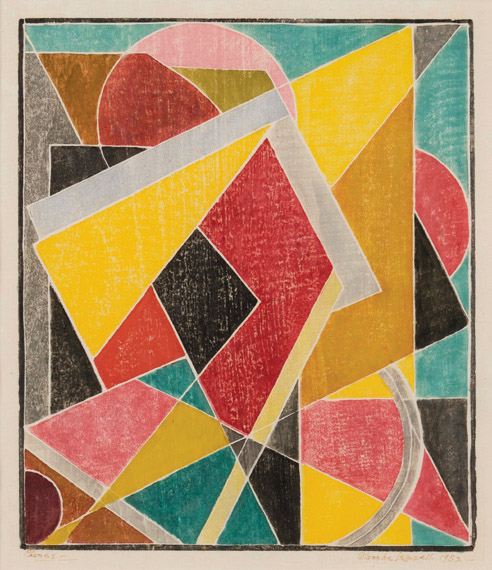
Planes II, block cut 1952, printed 1952, color woodblock print, 19⅛ x 21⅛ x 1½ (framed). Art Museum of West Virginia University Collection, gift of Harvey D. Peyton. 2004.1. Fauvism, Cubism and Abstract Expressionism all factored into Blanche Lazzell’s masterful white line woodcuts and paintings. Bruce Museum visitors are offered a rare glimpse at the work of this 20th century artist. At a time when only women of means had access to art training and even fewer had the chance to establish working studios and professional careers, Lazzell was a standout. This is the first monographic exhibition of her work in nearly two decades.
Lazzell had an extensive arts education, earning an undergraduate degree in fine art at West Virginia University, furthering her studies in New York, Paris, and Provincetown, MA. She took classes alongside Georgia O’Keeffe at the Art Students League in New York, and worked with Cubists Fernand Léger, André Lhote, and Albert Gleizes in Paris while a student at Académie Julian and Académie Moderne. She studied with Abstract Expressionist painter Hans Hofmann after putting down roots in Provincetown, MA. It was during her years in Provincetown, where she taught and maintained a studio, that she became known as a master of white line woodcuts. Her bright hues, simplified forms, and a flat Japanese aesthetic was an amalgam of influences that she distilled into a uniquely American–and highly personal—art form.
Women of talent and means flocked to Paris in the early part of the 20th century for the freedom it offered. Afterwards when Lazzell set up in Provincetown, she did not have a key patron, as O’Keeffe had in Alfred Stieglitz. Her smallish prints —which were easy to frame, wrap, and ship for inclusion in exhibitions—were at times perhaps dismissed as of lesser quality to painting. And, there was the matter of her family’s decision to donate her works after her death in 1956 to the West Virginia University Art Museum, in effect removing her art from major markets. The exhibition, featuring more than sixty paintings, prints, and unique works on paper, acts as a curative.
Bruce Museum curator Jordan Hillman singles out Lazzell’s Provincetown Church series that moves from charcoal preparatory drawing to woodblock to white-line print, and finally to oil painting. It was undertaken the year before her second trip to Paris, and offers “a unique glimpse into Lazzell’s creative process but also anticipates the increasingly abstract and flattened quality of her later work,” she said.
The Bruce’s presentation is unique—it’s organized chronologically, has new didactic materials, works from the Museum and local collectors, and incorporates an in-gallery interactive space. The exhibition will travel to the Albany Institute of History and Art and then to the Provincetown Art Association.
— Kristin Nord
- The Art Center
The Art Center, Dover, NH • theartcenterdover.com • Ongoing

Installation view of the Contemporary Abstract exhibition. Courtesy of the gallery. The Art Center, nestled in a mill building at the heart of downtown Dover, is filled to bursting with art, artists and artmaking. The most recent exhibition, Annual Contemporary Abstract Exhibition, took up most of the space in the gallery with abstract contemporary art from national and international artists. This year’s exhibition was dedicated to Tim Gilbert, an Art Center member artist who sadly passed away in October 2024. In the back of the gallery, a smaller exhibition, The Abstract 4: Abstracting Winter in New England, featured themed work by regional New England artists. Sequestered in a partially enclosed corner is the ongoing Small Works show, with pieces available for purchase in a varied mediums from painting to woodworking to sculpture.
The Art Center is an open-concept space offering visitors clear views of working artists in their studios. Artists can be seen coming and going from their work, sharing ideas and greetings with each other and with owner Rebecca Proctor. The mixed-use Washington Mills building invites collaboration between local artists and businesses, of which The Art Center is a part.
In addition to its being a gallery space, The Art Center also provides studio spaces for working artists ranging from private rooms to open cubicle-style arrangements. The Art Center hosts two artist residencies on-site, one for printmaking, the other for painting. For both residencies, each artist has four months to create a body of work to be shown in a group show at The Art Center the following year. The Center puts three artists through each program annually. The printmaking studio, complete with two different printing presses and a variety of other materials, is also available to rent for three-to-four-hour sessions. Proctor runs a custom framing business out the space as well.
The gallery is going through changes in the coming months as Proctor works to move some of the studio space and materials to a newly purchased third-floor suite in the same building. The new space will include pottery, the existing printmaking studio and more. “People can look in and they’re going to see people doing pottery and printmaking in an open setting,” said Proctor of her plans.
— Autumn Duke
- AS220
AS220, Providence, RI • as220.org • Ongoing
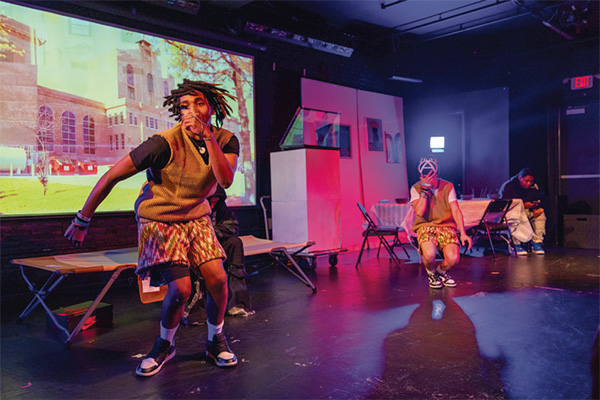
AS220 Youth perform at annual FutureWorlds afrofuturist hip hop production. Photo: David Lawlor. AS220 is a non-profit community arts organization founded in Providence, Rhode Island in 1985 as an inclusive space for artists—a place where artists could freely experiment and explore their interests without the constraints imposed by art institutions, commercial galleries, and critics. Since its inception, it has been a cornerstone of Providence’s vibrant arts scene and remains committed to its mission of making the arts accessible to all.
AS220 offers numerous opportunities for artists and performers to showcase their work to the public. The organization hosts an array of exhibitions, concerts, and performances throughout the year across its many galleries and stages. AS220 also offers access to community studios and workspaces for practicing artists, including painting studios, print shops, a darkroom, media arts facilities, a recording studio, and spaces for dance, theater, and improv. Numerous workshops and classes are available to the public for those looking to learn new creative skills.
The organization also empowers young Rhode Islanders through AS220 Youth, which offers after-school arts programs. Drawing inspiration from hip-hop, Afrofuturism, and social justice, the program provides multimedia arts instruction in visual, media, and performing arts, giving young people the tools to express themselves and engage with critical social issues.
A major component of AS220’s commitment to fostering the arts is its resident artist program. The organization provides affordable live-work apartments to approximately 65 artists across three mixed-use buildings in downtown Providence, the majority of which are government-designated affordable housing units. Residents also have convenient access to AS220’s studios and art-making facilities, as well as exclusive opportunities to exhibit their work or present performances to the public.
Artists of all disciplines and backgrounds are welcome to apply for residency in these live-work units. Since many of these apartments are designated affordable housing units, applicants must be below a maximum income threshold to qualify. The application process includes submitting an artistic biography, resume, and work samples. Shortlisted candidates are invited to interview with a panel of AS220 residents and staff. For more details, including information on current opportunities, visit as220.org/live-work-studios or email live-work@as220.org to be added to the vacancy notification list.
— Michael W. Zhang
- Kate Hargrave: The Journal
Elizabeth Moss Galleries, Portland, ME • elizabethmossgalleries.com • January 10–March 8, 2025
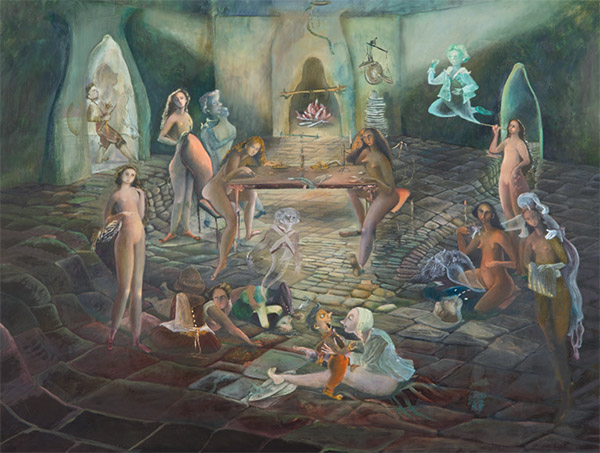
Kate Hargrave, The Fisherman’s Shadow, 2023, oil on birch panel, 30 x 40″. Courtesy of Moss Galleries. In a statement about her work on her website, Maine-based artist Kate Hargrave traces the subjects of her complex and intriguing paintings to a range of sources, from art history and children’s books to “early peer relationships, parenting and caregiving.” All of those sources are in evidence, often in a brilliant fusion, in the nine, largish oil-on-birch-panel paintings that comprise Hargrave’s first solo show.
Take The Orchard Road: the sheer number of mainly pubescent female figures—dressed, half-dressed, naked—involved in all manner of activities on a dark tree-lined thoroughfare might bring to mind Hieronymus Bosch. Hargrave creates her own garden of earthly delights yet filtered through the consciousness of a teenage girl. “With a willingness to indulge my own sensibilities,” Hargrave has explained, “I explore where memory and the subconscious reveal an adolescent realm in my work.” This statement ties her to Surrealism which, art historian Mary Ann Caws wrote recently in The Brooklyn Rail, “guarantees the constant exchange and thought that must exist between the exterior and interior worlds.”
Paintings like The Milkman’s Arrival, The Babysitter and The Penpal hark back to the dream-like scenarios in certain Leonora Carrington canvases. Hargrave is more of a storyteller: each canvas, in title and imagery, prompts diverse storylines of, in Hargrave’s words, “vulnerability and self-determination.” As your eye takes in the vignettes that unfold in humble fairytale interiors, you’re invited to wonder who the milkman, babysitter and penpal are and what their roles might be in this parallel world.
In The Fisherman’s Shadow a number of spectral apparitions interact with the figures, their wraith-like forms floating, grasping, hovering. Again, as one engages with the details in what Hargrave calls this “ambiguous territory,” one is tempted to uncover the mystery of this strange tableau, to start a “once upon a time” tale.
A 2003 graduate of the Rhode Island School of Design, Hargrave is starting to appear on the radars of art aficionados in Maine and beyond. It’s no surprise: the paintings are remarkable in their sophistication and vision. This is a debut to remember.
— Carl Little
- AEROSOL: Boston’s Graffiti DNA, its Origin & Evolution
ShowUp Gallery, Boston, MA • showupinc.org • Through February 16, 2025
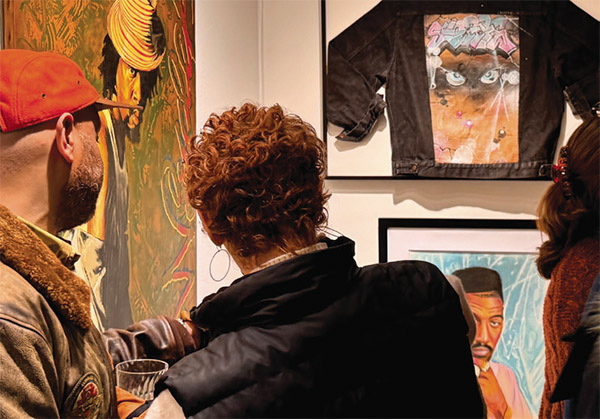
Visitors view works by David “DS7” Taylor (left), Rob Stull (top), and Chepe “Sane” Leña (bottom). Photo: Aron Lee. There’s nothing more sacred than when a group of artists find their kindred and commit to their craft boldly and unapologetically. In a time when the history of people of color is under the gun of censorship, it’s the artists who dig their heels even deeper to sustain their presence. Walking into the gallery, one is met with the immediate presence of energy, history, and artistry. Whether it’s Shea Justice’s parchment display of the shadows of collage art whose images travel back to Jim Crow legacies fiercely contested by Fannie Lou Hamer and James Baldwin. Or Timmy “Zone” Allen’s imagery of the historical racialized violence of policing alongside the monochromatic figures of Langston Hughes, W.E.B. Dubois, and a lone figure of Harriet Tubman next to an Indigenous child noting the cultural intersections of colonialism. Or the nod to a futurist and colorful burst of nonbinary Black faces in a digital simulation by Barrington “Vex” Edwards. As a viewer, the thematic range of this aerosol art reads more like a cultural document that should reside back in the open spaces of Boston as a permanent historical archive, not the transient spaces of art galleries.
A short documentary by filmmaker Paris Angelo airs on a continuous feed in a makeshift theater whose walls cocoon the viewer in a dark landscape mimicing the vibrant art that was once birthed under a night sky. In a poignant moment in the film, Chepe “Sane” Leña confirms the artistry not as random, stressing that one had to be a part of the culture, and not simply possess the ability of can control. The culture that these artists created is similar to that of historical-diasporic Maroon culture, a practice that Dr. Tiffany D. Pogue states where people of color “liberated themselves in a space in which they could be absolutely sovereign and express themselves culturally.”
A dated newspaper article headlines Peters Park Street Artists Decry the Loss of Their Wall. Next to that headline is a photograph of ten writers standing together, unwavering, poised as a clan whose individual stances/body language translates as a knowing that the world is their wall. It is their presence on the walls of this gallery that amplifies a lineage of storytellers whose voices are unwavering, their art enduring.
Curated by Jennifer Mancuso, the exhibition also features artists Ricardo “Deme 5” Gomez, Rob Stull, and David “DS7” Taylor.
— Asata Radcliffe
- Franklin Williams: It’s about Love
David Winton Bell Gallery (The Bell) at Brown University, Providence, RI • bell.brown.edu • Through December 8, 2024
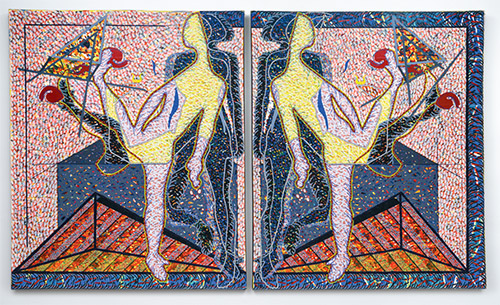
Franklin Williams, Twins (Pt. 1 & 2), 1976, acrylic on canvas, 71 x 120 x 3″. Courtesy of Parker Gallery, Los Angeles. Franklin Williams is the quintessential contrarian artist. He has maintained a meditative studio practice for sixty years, while living a committed family and teaching life, largely eschewing external pressure from institutional and market trends. The resulting unique work draws on the folk and craft traditions that he learned in his close Utah family.
Cutting Apron Strings, which speaks to the imminent demise of his mother, has intricate stitchery on pieced-together fabric. The stitchery is open, curved, patterned and lyrical–silver on a geometric ground of red, blue, purple, and black. The diamond shape has the lower half folded open as if the life within is still present.
In Pink Tea, a tribute to his family, created in acrylic and twine, the sexualized central image is the generative rising force that bears heart-shaped offshoots. Williams was an undiagnosed dyslexic in his youth, and also challenged by undiagnosed color vision deficiency. He recalls studying geometric patterns under a quilting frame as a young child. Family encouragement of his artistic efforts laid the base for his future development.
The love and support of his wife, Carol, to whom he has been married sixty years, is the inspiration for much of his work. Twins (71 x120 x 3 inches), which features two mirror images of a dancing figure, is executed in acrylic on canvas. The shared joy of the feminine figures is palpable, and the brushwork of dots and dashes brings to mind the stitchery that is so prevalent in many of his pieces.
Secret Sweet Slovakia, one of the most recent pieces, picks up techniques that are present in earlier works from the sixties. Crochet thread, feathers, acrylic, vinyl, and paper are a few staples of Williams’ intuitive process. Often his handprints and fingerprints appear in the works, both as a patterning device and as a literal representation of his hands at work. It’s about Love is an apt title for this singular exhibition, which clearly shares with us Williams’ central tenet: “To this day I’ve been a dreamer and I believe in magic.” This writer encourages you to experience this unique visual gift.
— B. Amore
- Seeing Landscape
Lapin Contemporary, North Adams, MA • lapincuriosities.com • Through December 28, 2024
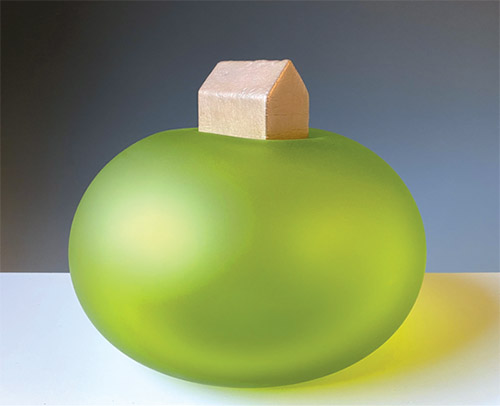
Jen Violette, Large Hilltop Barn, 2024, blown glass and bronze, 6.75 x 8 x 8″. Courtesy of the artist. This seemingly disparate, yet smartly edited exhibition is the fourth at what Cristina Barbedo calls her “emerging gallery” founded last April in North Berkshire’s historic Norad Mill. A Brazilian-born ceramist turned jewelry designer, Barbedo seeks out (by networking and trolling social media) visual artists who catch her eye, then links them with others who share stylistic or narrative traits to curate an exhibition. In this case, it’s a photographer, multimedia artist and graphic designer in Seeing Landscape.
John Lanterman, a Berkshire landscape architect for whom photography plays a supporting role, is the show’s lens man. His black-and-white images are riveting for the way cloud-splashed skies spill light over hills, meadows and groves of trees. In one, a tiny fragment of the moon hangs above roiling masses of shadow and light. In another, sunlight animates shimmering crowns of aspens.
Wilmington, Vermont-based painter and glass artist Jen Violette uses barn-shaped structures as visual tropes in multiple paintings and blown-glass pieces of blue, tangerine and lime. Often they rest on pillows of glass. In one significant departure, she positions a grove of glass trees in a grid suggesting human order imposed on nature.
Graphic artist Douglas Gilbert is Barbedo’s husband and business partner. They relocated from New York to Williamstown in 2022. His signature logo, a rabbit or lapin, inspired the gallery name. Gilbert coaxes shadowy, black-and-white images of hills, meadows and trees from thickets of crosshatched charcoal lines and dashes.
Although widely different in their chosen media, the three artists share common ground in expert craftsmanship and rural subject matter.
The rural aspect extends to mountain views visible through the loft gallery’s massive windows in the Norad Mill. Built in 1863 to process wool, the four-story mill is now a small-business shopping center. Its location on the Route 2 “Cultural Corridor” between MASS MoCA in North Adams and the Clark Art Institute in Williamstown is a strategic advantage, Barbedo says, in attracting New York and Boston-based visitors who tend to buy art. She also makes diverse use of the loft space with a studio for her jewelry making and a gift shop stocking her work and that of her husband as well other artisans.
“It’s all a work in progress,” Barbedo said. “I hope to grow a gallery.”
— Charles Bonenti
- Awre Journey: Twentieth-Century Afri-Caribbean Migration
Housatonic Museum of Art, Bridgeport, CT • housatonicmuseum.org • Through February 21, 2025

Iyaba Ibo Mandingo, Every day new people arrived, looking for work, any kind of work. 2023, acrylic on panel board. In Awre Journey: Twentieth-Century Afri-Caribbean Migration, Afri-Caribbean (1) artist Iyaba Ibo Mandingo tells the story of his ancestors’ immigration to Europe and North America and his immigration to the U.S. The paintings (2020–2023) in Awre Journey are also an ode to African American artist Jacob Lawrence’s The Migration Series (1940–1941), sixty panels that chronicle Black Americans migrating from the Jim Crow South to the industrial North.
Mandingo has studied Lawrence’s work and writes, “[Lawrence’s] dynamic cubist style brings each panel to life with sharp angles and primary colors….[he] created captions…that told the entire story.” (2) Like Lawrence, captions accompany Mandingo’s uniformly sized paintings. Awre Journey, however, features an extra panel because as Mandingo was completing the series, Harry Belafonte died, prompting a group portrait of Sidney Poitier, Cicely Tyson, and Belafonte to “mark the passing of three legendary Caribbean-American icons.” (3)
While the back gallery features additional work by Mandingo, Awre Journey inhabits the front room, hanging in an expansive, storyboard style grid. The chronological narrative begins in 1908, takes us through the Windrush Generation—approximately a half-million Caribbean people coming to Britain (1948–1970s)—and then illustrates Mandingo’s childhood experiences in Antigua and the U.S.
Visually, Mandingo strikes a thoughtful balance between the artist’s own style and Lawrence’s. Some works incorporate The Migration Series’ iconography, including “grips” (English suitcases) and birds; and Mandingo’s last panel mirrors Lawrence’s (a crowded railroad station, captioned “And the migrants kept coming”) with Afri-Caribbean people in a boat on choppy water, captioned: “But we continued to come, risking everything, hoping for better tomorrows.” Mandingo also selectively introduces some of Lawrence’s formal qualities, including facial features rendered with thick brushstrokes. Many of Lawrence’s faces in Migration had minimalist or no features, yet all of Mandingo’s Afri-Caribbean visages are detailed and express emotions such as joy, exhaustion, and affection. Interestingly, Mandingo draws no features on the white faces, a motif that concomitantly operates as a nod to Lawrence; a symbolic erasure of hegemonic narratives about immigration; and a recentering of Afri-Caribbean people and the important stories they hold.
— Terri C Smith
(1) This article uses the artist’s preferred term “Afri-Caribbean”: “For me Afri-Caribbean is a counter to the labeling Afro-Caribbean…defining ourselves is an important part of identity.” (email from Mandingo to the author). (2) Unless otherwise attributed, quotes are from the exhibition’s wall text. (3) Email from Mandingo to the author
- The Aplomb Project
Aplomb, Dover, NH • aplombgallery.com • Ongoing
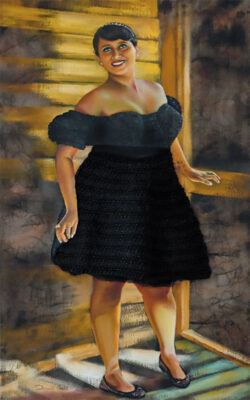
Stitched Together, 2024, painted by Danielle Festa with crocheted element by Sravya K, oil on linen. Courtesy of the artist. In the midst of the COVID-19 pandemic, portraitist Danielle Festa painted the first in an ongoing series of portraits depicting trauma survivors, a series now known as The Aplomb Project. What started as a personal project has grown into a gallery space, a non-profit organization and an international community of survivors and supporters with Festa at the center.
Festa takes inspiration from classic works of portraiture, chosen by the people she paints. Her subjects are given a voice throughout the process. They make playlists for her to listen to and choose colors used in the piece. Part of what makes The Aplomb Project so unique and personal is that, after the portraits are exhibited, they are gifted back to the subjects. “This is going to end up on their walls, and it’s supposed to be a reminder of their strength, so it makes sense that they would have a lot of input.”
The survivors choose their own, often visually arresting, outfits. “The importance of what a survivor wears is really critical to their own feeling of self-worth and their newfound confidence matches their exterior,” said Festa, who incorporates textiles into her work, allowing her subjects’ clothes to leap off the page. For Stitched Together (2024), the subject Sravya K crocheted her own dress, and gave Festa a piece of the dense black knitwear to use in the work.
Festa is conscious of potentially triggering content while still encouraging survivors to share their stories. In the gallery, the survivors’ stories are located on a small screen, and visitors can choose to read them or not. Festa hosts workshops at her gallery in Dover where attendees engage in artmaking with the guidance of experts under a model of trauma-informed care.
In a world that too often shies away from even saying words like rape, incest and sexual abuse, perpetuating the shadowy culture of silence and denial in which these atrocities thrive, Festa’s work shines a light into that darkness. Yet, despite the nature of these topics, it is not through violent imagery that Festa reaches her audience. Instead, Festa invites us to the conversation through lovingly crafted depictions of survivors, standing proud, with aplomb.
— Autumn Duke
- Overview
The Tomaquag Museum, Exeter, RI • tomaquagmuseum.org • Ongoing

The Tomaquag Museum is located in a white farmhouse-style building nestled in the woods of Arcadia Village in Exeter, Rhode Island. Founded in 1958 by Princess Red Wing, a Narragansett-and-Wampanoag historian, and the anthropologist Eva Butler, the Museum is dedicated to Indigenous culture and history, with a particular focus on the communities of southern New England—including the Narragansett people, the only federally-recognized tribe in Rhode Island. In 2016, the Museum received the National Medal for Museum and Library Service (a framed photograph of Michelle Obama presenting the award to board member Christian Hopkins and the museum’s executive director Lorén Spears sits on a table by the entrance).
The name “Tomaquag” comes from the Narragansett word for “beavers,” an appropriate name for an organization that presents the concept of indigeneity as part of a complex and interconnected system. Within the interior gallery space, different displays engage with various aspects of social life—such as food, clothing, and trade—which are intertwined with the region’s natural resources, emphasizing the harmony between culture and nature. Additionally, the museum showcases the rich cultural production of southern New England communities through displays of intricately-woven basketry, pottery, historical and modern regalia, and an array of ornate beadwork pieces. Exhibits also highlight the Indigenous history of the region by featuring the lives and achievements of prominent figures and leaders from Rhode Island.
Objects on display are referred to as “belongings,” underlining their personal and human connections. The museum staff excel at contextualizing these belongings within Indigenous culture, effectively bridging historical narratives with contemporary matters. This emphasis on Indigenous voices is a distinctive feature of the Tomaquag Museum. Through first-person accounts, community members can share their memories and experiences, giving them control over their own history. Moreover, the museum highlights current Indigenous artistic and cultural production in New England by promoting the works of contemporary artists and hosting storytellers and speakers.
The Tomaquag Museum plans to relocate to a new site on the University of Rhode Island campus in Kingston in the near future. The new facility will enhance the museum’s capacity to engage and connect with the public and serve as a hub for research. This expansion will also ensure that the Tomaquag Museum continues its vital role in preserving and celebrating Indigenous heritage in New England.
— Michael W. Zhang
- Belle Terre: Jennifer M Johnston, Jonathan MacAdam, Colleen Pearce
Three Stones Gallery, Concord, MA • threestonesgallery.com • Through November 24, 2024
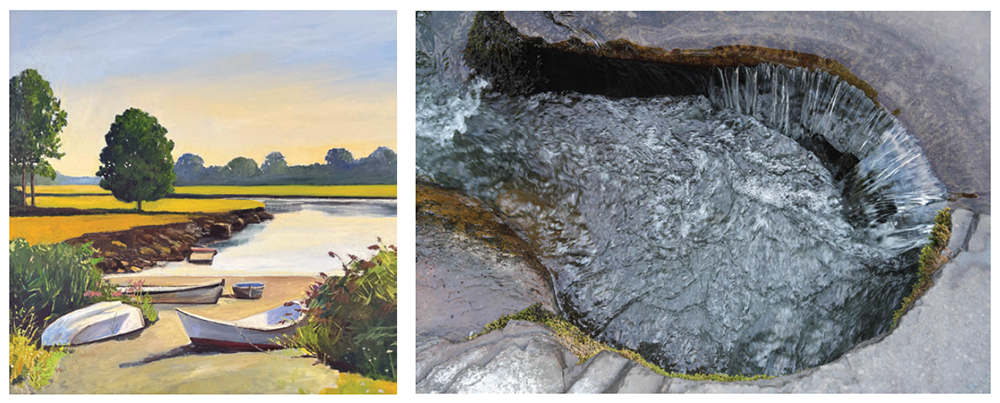
Above, from left: Jonathan MacAdam, 2024, Boat Yard Essex, oil on canvas, 24 x 24″. Jennifer M Johnston, Catskills I, 2024, archival ink jet print, limited edition. Courtesy of the artists. Belle Terre is Italian for “Beautiful Lands.” This exceptional exhibition could not have a better title. The range of work, from the almost abstract photography of Jennifer M Johnston to the soft realism of Jonathan MacAdam, to Colleen Pearce’s expressionistic paintings, shows viewers the beauty and love that the artists have for this earth—a place we are so fortunate to inhabit. This exhibition sharpens our appreciation and helps us to see anew.
MacAdam, born in London, shares his beloved Concord River, an oil on canvas painting that leads us from the wide triangular foreground of blue water to reflections of the river banks on either side, curving to a vanishing point of mystery. Marsh at Dusk, an impressive 36 x 72 inch painting gives us a wide vista, while Boat Yard Essex is a more intimate portrait which still continues the theme of peaceful, reflective water.
Johnston’s photographs of water in nature border on the surreal. Catskills II shows us sheets of water spilling over an edge of rock. The water’s luminescence is filled with shades of grey, lavender, and white—a “scene within a scene.” Catskills I captures an unusual circle of stone with clear water falling from the sides and filling the center with dappled texture and light. Higgins I looks as if it is another water portrait, yet is actually a photograph of colorful rock striations in rust, blue and grey. The photographer’s eye sees in a unique way and provides us a fresh view of the natural world.
Earth arranging her Summer Skirts, by Pearce, is a seductive oil on Yupo paper painting that offers us the jumbled lushness of blooming flowers and curling, reaching leaves. Pearce’s Thunder Hole, a dynamic painting of a rock formation that opens into the ocean under a sky of swirling clouds pulls us skyward from the earthbound stone.
Three Stones Gallery, named by Jennifer Johnston for the trilithon that forms the center of Stonehenge, is a perfect venue for this exciting exhibition which embraces the many vicissitudes of the Earth’s beauty. A stunning show that takes your breath away!
— B. Amore
- The Elusive Art of Kumi Yamashita
Flinn Gallery, Greenwich, CT • flinngallery.com • Through November 6, 2024
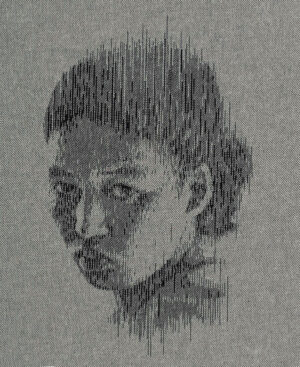
Warp & Weft (Mother No. 2), 2013, fabric with threads removed,15 x 13″. Photo: Paul Takeuchi. Opening the Flinn Gallery’s 2024–25 season, The Elusive Art of Kumi Yamashita offers a glimpse into the contemplative vision of Yamashita, whose work explores her fascination with the human form and human condition. She’s been described as a “conceptual humanist,” and owns it: “I think that might be one of the best descriptions of my work and subject matter,” she says. The process of bringing these ideas to fruition is a painstaking one, although the work comes to Yamashita “fully formed.” Then, she says, “I see my job as attempting to faithfully transfer that vision into the physical world.” Exhibition viewers can expect to see subtly provocative works that embody this approach.
Yamashita’s “Light & Shadow” series suggests the nonphysical underlayer of image, reminding us that nothing is static. Light is both illumination and life force—shadow and light are mediums. Carved wood numbers affixed to the wall, strategically illuminated to suggest a face; all is positioned to give definition to human form, with echoes of shadow boxes and early photography. Yamashita’s portraits are no ordinary portraits: taking the concept of pointillism to a three-dimensional level, Yamashita “draws” with thousands of galvanized nails and a single thread that connects them, coalescing like a constellation atop the image. These threads are both literal and metaphorical: “Experiencing common threads that connect us all has always been an inspiration for my creativity,” Yamashita says.
Born in Takasaki, Japan, Yamashita currently lives and works in Woodstock, NY. Her work is held in the collections of institutions the world over, including museums and corporations. In the Flinn Gallery iteration, curator Leslee Asch hopes viewers will “expand their understanding of the possibilities of the varied media [Yamashita] skillfully employs, and the breadth of her vision.”
As philosophers and artists have long understood, without light, there is only darkness. As Carl Jung said, “Everyone carries a shadow, and the less it is embodied in the individual’s conscious life, the blacker and denser it is. If an inferiority is conscious, one always has a chance to correct it.” Yamashita speaks beautifully to this individual—and collective—truth.
— Julianna Thibodeau
- Life Forms
Corey Daniels Gallery, Wells, ME • coreydanielsgallery.com • Through October 15, 2024
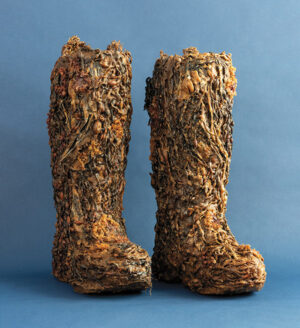
Celeste Roberge, Rising Seas(onal) Collection: Seaweed Will Be Lapping at Your Doorstep #2, 2023, seaweed and wax over wax cast Muck boots, each boot, 18 x 5 x 13″. Courtesy of the artist. Life Forms, a series of exhibitions that will take place in different venues across Maine over the next four years, kicks off with this showcase of the twelve artists in the collective: Leah Gauthier, Jackie Brown, Lynn Duryea, Kazumi Hoshino, Elaine K. Ng, Bronwen O’Wril, Ashley Page, Veronica Perez,
Celeste Roberge, Naomi David Russo, Ling-Wen Tsai, and Erin Woodbrey. It’s a diverse and brilliant line-up.Roberge’s Seaweed Will Be Lapping at Your Doorstep #2 envisions the future by way of a pair of wax cast seaweed-covered Muck boots—“imaginative survival gear,” she calls them. In a like manner, Woodbrey presents single-use plastic containers for surface cleaners and water, covered in ash, plaster, and gauze—effigies of consumer goods (or bads).
By contrast, Russo offers fanciful practical creations, Squiggle Mirror and Coil Lamp, each incorporating curved elements that enhance the wall fixtures. The small white oak pieces in O’Wril’s Pick Me Up also play on curvature, smooth shapes that might be part of a puzzle. Elsewhere, Page’s wire constructions, Black and Porous and Black Seed, are loose and linear.
Duryea’s terracotta Slant #19 and Tilt are soft-toned and engagingly off-center—constructivist yet warm—while Brown’s 3-D printed ceramic sculptures Twister and Elemental, from her “Strata” series, are rough-hewn and organic. Hoshino’s Fragments of Memory highlights the textures of light and dark stone via an arrangement of five small tabletop sculptures.
Tsai’s Chair and Bench from her “Rising/Sinking” series might be stage sets for absurdist dramas, the simple wood furnishings embedded in square light-blue milk-paint platforms. Perez’s large-scale suspension, made from artificial hair, wood, and burlap, also seems theatrical, the conceptual centerpiece for an existential one act.
Wall works include Gauthier’s silk thread-on-linen pieces with acrylic and gouache, hypnotic in their circular precision/arrangement. Ng takes a different route, using plant-dyed cotton and eri silk to evoke silky rocks, a lumber pile, and a greenhouse roof.
Almost all the work in the show dates from the past couple of years. Future iterations of Life Forms promise to trace the evolution of this
dynamic dozen. Learn more about the series at lifeformsart.org.— Carl Little
- Vivien Russe: Networks
Sarah Bouchard Gallery, Woolwich, ME • sarahbouchardgallery.com • Through August 4, 2024

Vivien Russe, Networks, 2022, acrylic on panel, 10 x 10″ each. Courtesy of the artist. Juxtaposition is an artistic tradition dating back at least to the Surrealists who used it to create dreamlike imagery that created a sense of disorientation. Over the years Portland, Maine-based painter Vivien Russe has built her acrylic paintings around contrasting elements, placing side by side two or more images that play off against each other to create intriguing visual frissons. Some of them recall poet Allen Ginsberg’s “eyeball kicks,” defined as “the juxtapositions of disparate images to create a gap of understanding which the mind fills in with a flash of recognition.”
Russe’s show at Bouchard features several juxtapositions. In Again (Diptych), 2022, she pairs unfurling fiddleheads with an image of two small water-filled saucers. The coupling offers a challenge to fill that “gap of understanding” that lies between forms of nature and manufactured glassware.
Dispersed #2 (Diptych), 2022, combines fern fronds with what appears to be a transparent flower form set against a checkerboard pattern. This painting and two related pieces, Dispersed #1 and Dispersed #3, evoke the dissemination of seeds. They underscore what Russe says is the root of her recent work: the climate crisis and the damaging effects of human activity on the natural world and the planet.
Russe traces inspiration for the work to a visit to Acadia National Park in 2018 and a trip to view Renaissance paintings in Italy the following year. In Finding (Diptych), 2021, she places a study of lichen alongside a schematic of a dome. In doing so, she answers her own question: “Why is a lichen less holy than St. Peter?”
Moss and Maple, both 2023, celebrate the resplendence of the natural world. The former highlights bright green ground cover, the latter, elements of the tree: seedlings, fall-burnished leaves, flowers.
Russe presents a darker vision in one of her most recent pieces, In Memory Of, 2024. Here, fungus appears to spread over an old headstone. The artist admits to being discouraged by “the increased environmental degradation from political divisions, capitalism, population displacement and war,” yet her work,
so strikingly conceived and composed, carries a distinct visual pleasure.
And there you have it: the paradox of the world we live in.— Carl Little
- Scraps With Nature – Mary Admasian
T. W. Wood Gallery • Montpelier, VT • twwoodgallery.org • Through July 22, 2024

The Red Divide, 2024, maple, layered plywood, bandsaw blade, graphite, acrylict, 17 x 81/2 x 4″. Mary Admasian’s body of multimedia work is on the move to new heights. Known for creating in the spirit of environmental and social/political activism with intentions that run deep, these sculptures allow the viewer to come to their own understanding. Admasian shares, “I call myself a seed planter. I use materials as a metaphor for other things.” Scraps With Nature at the T. W. Wood Gallery reveals true architectural mastery in sculptural assemblage. At first glance, structural lines and a limited color palette (primarily natural wood, blue, black and white) reveal texture that allows the voices in the reclaimed scraps of wood to sing. While small in scale, the thirty-one pieces are at once elegant in surface and line and command attention. The exhibition merges celebrated series of her work as well as fourteen new constructions. As for her palette, Admasian is known for using the same blue in her work that marks trees for felling. However, the blue in her constructions signifies a rebirth of the wood in a new form.
Upon closer viewing, stones, pearls, and natural crystals have a relationship with the wood. A favorite title in the exhibition is Pearl on Deck—its shapes reminiscent of a boat bottom with a pearl added to draw energy to the sculpture, revealing the artist’s playful side.
Barbed wire makes an appearance to represent tension or division in works like Bound by History and The Red Divide. “I am influenced by the exploration of balance and barriers between objects—positions and connections—as well as implicit boundaries of familial, political and social covenants and connections.” Admasian’s black and white multimedia pieces have a unique energy created with needles and black ink on a surface that emits energy and transcendence. Her repurposed piece from Vermont’s Highland Center for the Arts on the solar eclipse employs gossamer paper—a layered eclipse evolution—searching for totality. A perfect homage to her home state of Vermont which celebrated this celestial experience in the line of totality.
— Kelly Holt
- What, Me Worry? The Art and Humor of MAD Magazine
Norman Rockwell Museum, Stockbridge , MA • nrm.org • Through October 27, 2024
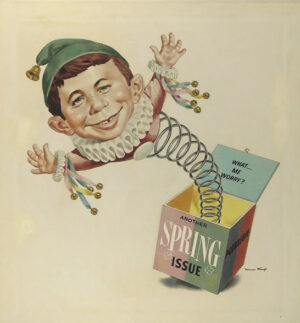
Norman Mingo (1896-1980), What, Me Worry: Another Spring Issue, 1957. Cover illustration for MAD #33, (EC, 1957), acrylic on board. James Halperin Collection, Courtesy of Heritage Auctions, HA.com. MAD and all related elements ™ & © E.C. Publications. Courtesy of DC. All Rights Reserved. Used with permission. In a fraught election season, this retrospective on the art of pioneering counter-cultural MAD magazine illustrates how laughter can be a tool for social and political change. Co-curated by the Rockwell’s chief curator Stephanie Haboush Plunkett and illustrator/art journalist Steve Brodner, it showcases over 250 images by more than thirty artists in a dense, yet comic, multilayered exhibition that says as much about artistic collaboration as it does about lampooning American culture.
Launched in 1952 by editor Harvey Kurtzman and publisher William Gaines as an EC comic book series, MAD was converted to an illustrated magazine in 1955 to skirt potential censure by the industry’s Comics Code Authority. Aimed at young readers with a goofy, gap-toothed cover boy named Alfred E. Neuman as a ubiquitous presence, MAD hit a peak circulation of over two million in the 1970s, despite lawsuit threats and an FBI investigation. After 585 published issues, it continues today in curated reprints and a legacy of late-night television comedy.
Illustration art is story-driven, so viewers will scan hundreds of captions, narrative bubbles and wall texts as they navigate work by generations of artists, including a few women, who contributed to MAD. Theirs was a world in which writers pitched story ideas as blocked-out movie scripts that artists were later hired to visualize.
“It was done with tremendous care and skill,” said Brodner of the discipline required to take narrative direction and come up with arresting images on tight deadlines.
Mash-ups of subjects that do not normally go together mock correctness. Richard Williams’s substitution of MAD’s Neuman for the figure of Norman Rockwell in the latter’s 1960 Triple Self Portrait or the gorilla face Roberto Parada put on Vermeer’s Girl with a Pearl Earring are two examples.
Superbly drawn caricatures by Mort Drucker reprise the political power of the Sixties-era Kennedy family and the criminal reach of the Italian mafia in the 1972 film The Godfather, renamed “The Odd Father.”
By the 1990s, digital technology made pictorial changes easier and cut production time, though made “dinosaurs” of human artists, complained Brodner, saying, “no robot could do what they did.”
— Charles Bonenti
- Deserve What You Dream
NXTHVN, New Haven, CT • nxthvn.com • Through September 1, 2024
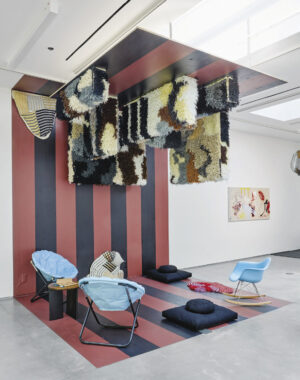
Installation view of Deserve What You Dream.
Photo: Chris Gardner. Courtesy of NXTHVN.Too often, exhibitions disregard a viewer’s body. Critic Brian O’Doherty famously noted this in his 1976 book Inside the White Cube. “The space offers the thought that while eyes and minds are welcome, space-occupying bodies are not.” With Deserve What You Dream, curator Marissa Del Toro centers the visitor’s body and encourages resting and daydreaming as forms of resistance, which she posits is especially important for Black individuals and people of color. The introductory signage shares that this exhibition—with works by Derrick Adams, Isaac Bloodworth, Jihyun Lee, and Sarah Zapata—is inspired by Tricia Hersey’s 2022 book, Rest is Resistance which “proposes [that] when we allow our bodies to rest and nap, we resist the status quo and provide ourselves ‘a portal to imagine, invent and heal.’” Deserve What You Dream is such a portal, creating comfortable-to-cozy areas for reading, drawing, and contemplation throughout. By placing artworks in a lively conversation that wisely resists literal exposition of the show’s themes, the curation invites visitors to splash around in what Hersey has described as the “spiritual and somatic dimensions” of rest as resistance.
Play is foregrounded at the entrance with Bloodworth’s lighthearted, street-facing mural, featuring blue waves and “Joy the Black Boi” on a floatie. Upon entering the lobby, Lee’s doll-filled shelf sculptures continue this sense of play. The exhibition also features her surrealist sketches that bear out Lee’s approach of
“maximiz[ing] the specific state between reverie and reality.” Water, a symbol of the subconscious, appears again in Adams’ Floater paintings where adults are poolside with animal-shaped floaties. The only purely abstract works here are by Zapata, a Peruvian-American artist who explores identity, labor, and culture. These include large-scale, color field textiles that resemble shag rugs; fabric works from her “Gargoyle” series—exquisitely crafted interlopers that hug corners and melt down walls; and her site specific installation “A resilience of things not seen,” a sitting area that is as much a hug as a respite, not only anchoring the main gallery, but the bodies that rest there.— Terri C Smith
- “Tricia Hersey: Rest and Collective Care as tools for Liberation,” on Sounds True channel, YouTube, 2021.
- From artist statement on Jihyun Lee’s website
- Material Matters
Vermont Supreme Court Gallery, Montpelier, VT • vermontjudiciary.org • Through June 28, 2024
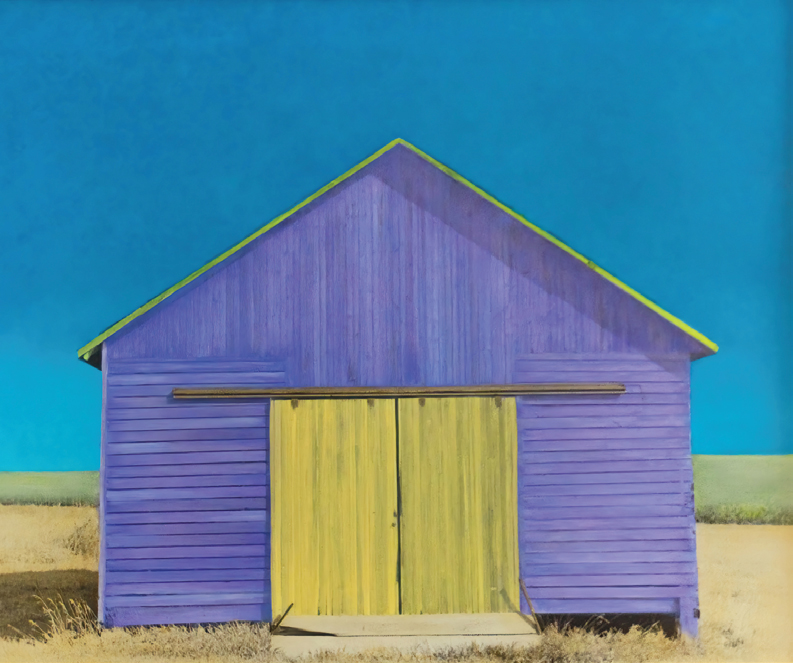
Victoria Blewer, Solitary Barn, 2023, hand-colored photograph, 15 x 12″. Courtesy of the artist. Form meets fantasy in Material Matters—Victoria Blewer’s solo exhibition at the Vermont Supreme Court Gallery. This exhibition, delayed first by the pandemic and then the 2023 flood in Montpelier, is worth the wait. Blewer, originally from New York City, moved to Vermont in the late 1980s. She is an acclaimed artist—receiving quite a few national and regional awards. One of her muses is the celebrated author Chris Bohjalian, her husband.
Inspired by a glance at a bumper sticker, “‘Change is inevitable. Growth is optional.’ And isn’t that what every artist strives for?” Blewer shows in two distinct bodies of work that she is pushing the boundaries of her medium with a bold visual vocabulary.
Her series of barns show her depth of photographic study in analog techniques. In this series Blewer is using silver print black and white barns, hand-colored with oil paint. In the work New Barn (2024), the architectural lines and symmetry create a beautiful formality while the play of color in the work vibrates with the push/pull of what is in the foreground and what is behind the barn. Blewer masterfully creates geometric shapes within the barns to break up the shapes with color. As a group, the barns are a delight of color theory meeting the lovely texture made by Kodak’s 35mm infrared film.
Lining the halls of the gallery are Blewer’s collages. Leading the eye back and forth in time using faded photography, newspaper clippings with antique adds, geometric patterns and wildlife. The collages are whimsical while making a statement on society—women’s roles ever-changing, how we govern, how we decide. Characters in stilettos wearing helmets prepare for battle. Street photography beckons the viewer to “Question everything, Leave your baggage here” with an all-knowing eye and flying UFO objects in the sky with a comic book character urging “C’mon son! Use your common sense! Think it through!,” bring the viewer on a time-travel journey. One favorite features a dark, grainy painted background with organic circular forms which almost feel like printmaking. A collaged bird floats upside down withing and old tinted landscape, the bird’s eyes are glancing up at a sign that reads “HOPE.”
— Kelly Holt
- Jungil Hong: The Time Being
ODD-KIN, East Providence, RI • odd-kin.com • On view May 19, 2024
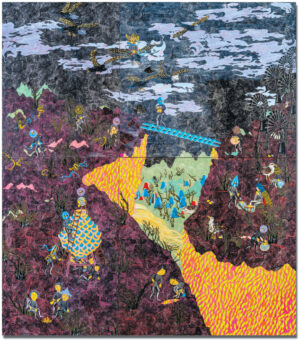
Jungil Hong, Snake Den Mesa, 2005, screen printed collage, 6 x 8′. Courtesy of the artist. Jungil Hong, a Korean-born, Providence-based artist, is reemerging in Jungil Hong: The Time Being. Both retrospective and introspective, the exhibition examines and reexamines Hong’s personal life and career. She got her start in collaborative live-work spaces like Fort Thunder, spaces that defined the art scene of Providence in the 1990s. Yet things have changed since then. “In the time between oldest and newest work in the exhibition I have questioned parts of my identity—as an immigrant, a mother, a daughter, a partner, an artist,” said Hong.
Hong repurposes and reimagines projects from different parts of her life. Jacquard weavings done during her time at the Rhode Island School of Design are given new life as sculptural objects, their beauty allowed to flourish beyond the constraints of their original purpose. Pieces from pivotal moments in her career make a reappearance, such as Between San Souci and the Setting Sun, a collage on wood made for the 2007 deCordova New England Biennial.
Table of Objects holds objects relating to road trips and watching movies as well as those found in nature and representing the passage of time. Some were made by Hong’s mother, whose presence can be felt throughout the exhibition. Hong’s Selfies and Portraits series explores the physical changes of the body over time, a thing of both anxiety and beauty for Hong. “For one who cherishes the accrual of time, I never imagined I’d fear the passage of years. I gather lines and dots, mapping the story etched on the surface of my existence, artifacts of fortunes of living.”
This show shines new light on the life and career of a woman foundational to the Providence art community. More than that, however, it offers a window into an artist’s two-decade journey of identity and self-discovery. “The exhibition explores the significance of parenting, being parented, projecting oneself onto others, absorbing what is given to you, being an immigrant, not having enough, having too much, comparing, and reflecting.” Viewers will see, perhaps, a little of their own journeys through time reflected in Hong’s evocative and expansive body of work.
— Autumn Duke
- 40 Years of Collecting
Cahoon Museum of American Art, Cotuit, MA • cahoonmuseum.org • Through December 23, 2024
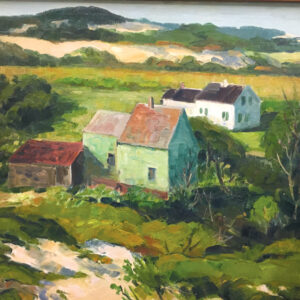
Daisy Marguerite Hughes (1882–1968), Cape Cod Dunes, n.d., oil on canvas, 37 x 45″. Collection of the Cahoon Museum of American Art. Gift of the Cahoon Society, 2013 2013.2. This year, the Cahoon Museum of American Art marks its 40th anniversary. In 1984, the museum opened in the former home and studio of folk artists Ralph and Martha Cahoon, and embarked on assembling a permanent collection. To celebrate the milestone, the museum has brought forth from storage an enticing array of works in varied media, with varied themes, stretching from the 1850s to the present.
With its maritime focus, the first room opens with Sunset in the Arctic by William Bradford, a Hudson School artist who ventured to the Arctic several times in the 1860s, which portrays a white colossus, amid pink-hued clouds, towering over the sailing vessels at the horizon. Alongside Bradford’s painting Bradford’s Iceberg, a small ceramic sculpture by the contemporary artist Valerie Hegarty mimics the behemoth, only it’s melting off the frame. The demise of the seemingly indestructible iceberg conveys that all things great and small contend with nature’s flux and fragility.
In the idyllic, Pissarro-like scene of Duxbury Clam Digger, Daniel Santry portrays the hard edges of the working man’s humble life. For Cape Cod vistas, there’s the chockablock Provincetown Waterfront by the early Modernist Nancy Ferguson and Daisy Hughes’ boldly rendered Cape Cod Dunes. In Truro-based Robert Cardinal’s remarkable Three Boats, sky and sea—without horizon—are one bright blue, ethereal space, imparting an abstract feel.
The homespun theme of the second room embraces folk art by pairing the classic portraits by Ralph Cahoon with Dorothy Davis’ later day paintings of young children. The room nods respectfully to Impressionism with Paul Moro’s thickly painted Gladiolas and Zinnias, a still-life blaze of lush flowers—even the table seems to shimmer—and with the calming In the Hills and the energized Trout Brook by the masterful American Impressionist John Enneking.
The depiction of a quaint mid-20th-century town in Cotuit Port Crossing by Wilson Barnett is balanced by A Matter of Time, Marieluise Hutchinson’s bucolic scene with a hint of Hopper.
Displayed in the museum’s intimate historic wing, the small yet wide-ranging exhibition is a prideful expression of the care and commitment that enabled the museum to grow its collection for the benefit of Cape Cod and beyond.
— Jack Curtis
- Nora S. Unwin: A Retrospective
Monadnock Center for History and Culture, Peterborough, NH • monadnockcenter.org • Through September 28, 2024
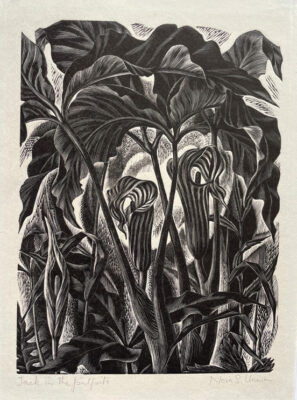
Nora S. Unwin (1907–1982), Jack in the Pulpits, c. 1954, wood engraving, 73/4 x 53/4 “. Photo: Collection of the Monadnock Center for History and Culture. The works of twentieth-century engraver and illustrator Nora S. Unwin (1907–1982) can be found at a roster of famous institutions—the British Museum, The Met, and the Smithsonian, to name a few. A wonderful and fitting surprise, however, is to discover that the world’s largest collection of her work resides at the Monadnock Center for History and Culture in Peterborough, NH, the town Unwin left England to visit in 1946 and quickly made her home.
The Center’s current retrospective features eighty of Unwin’s works in two rooms. The first room, arranged chronologically, includes already sophisticated drawings by a twelve-year old Unwin and enchanting early woodblock prints of animals and nature. Several of Unwin’s books are on display—she illustrated over 100 books and authored twelve—as are her engraving tools, and selected later works. The second room is arranged by major themes, including nature, spirituality, cats, and experiments in abstraction.
Most of the pieces are black-and-white woodblock prints, which Unwin typically hand-impressed, a practice demanding great precision to ensure print quality and consistency. Technically exceptional and richly detailed, her pieces are also emotionally evocative. Michelle Stahl, the Center’s executive director, says that, from a young age, the artist was able to convey emotional content with any subject, remarkably doing so “with basically the white of the paper and black ink.” In a print like Jack in the Pulpits, Unwin’s rendering of local flora flexes with the compressed energy of New England’s brief yet exuberant growth season.
Unwin came to Peterborough in 1946 at the invitation of her friend and frequent collaborator, American writer Elizabeth Yates. Artistically invigorated by the New England landscape, she decided to stay. She would live, teach, and create in New England (primarily in Peterborough) until her death in 1982. She left the contents of her studio (over 1,500 pieces including prints, engravings, books, sketchbooks, and collagraphs) to the Sharon Arts Center. Following a series of institutional mergers, the collection was donated by New England College to the Monadnock Center in 2022, fulfilling Unwin’s wish for her work to remain in her adopted hometown.
— Alix Woodford
- Dreams of a Common Language
Overlap Gallery and Project Space, Newport, RI • overlapnewport.com • Through June 15, 2024
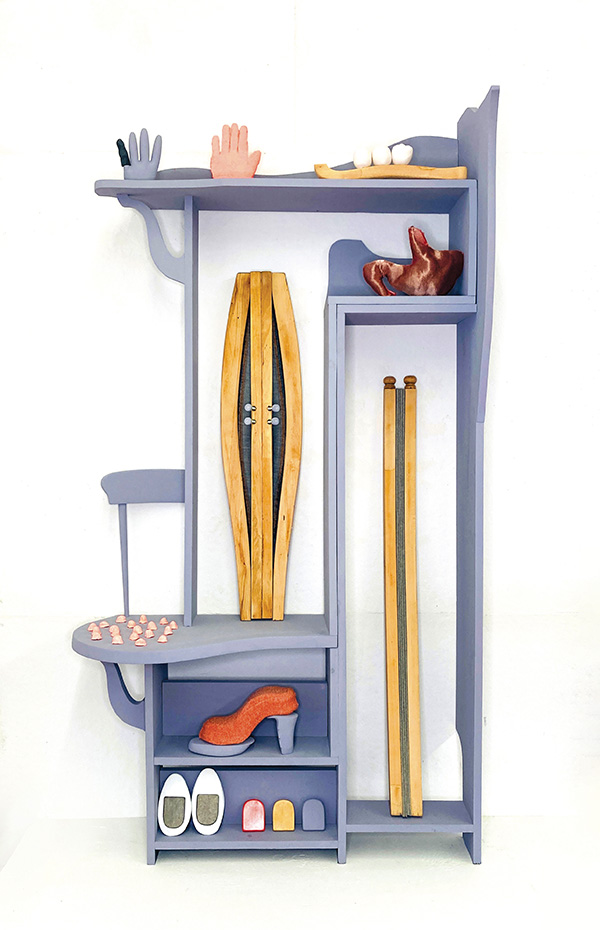
Lu Heintz, Habitus, 2021-ongoing, wood, plaster, steel, fabric, plastic, paper pulp, and found objects, dimensions variable. Photo: Lu Heintz. Overlap is a dynamic new gallery located just outside downtown Newport in a refurbished glass shop. Co-directed by artists Susan Matthews and Alicia Renadette, Overlap is committed to showcasing work that highlights rigor in craft, creating a space for underrepresented art that features textiles, installations, and other material investigations often spilling off the wall. Their upcoming exhibition Dreams of a Common Language promises a unique interpretation of fiber arts which will continue to push the gallery into the forefront of Rhode Island’s art scene.
The exhibition features three Rhode Island-based artists and educators. Lu Heintz, Elizabeth Duffy, and Anna McNeary are united in their explorations of
gender, craft, and identity through textiles, installation, and performance. Dreams of a Common Language takes its name from an Adrienne Rich collection of poetry from which the three artists have taken to sending excerpts to each other as a grounding, meditative practice.Meticulous in craft, Duffy studies the cyclical nature of clothing through her current project Wearing. This series involves her carefully unwinding braided scrap rugs, ironing and patchworking tattered scraps, and metamorphosing them into garments and wall hangings. The works often remain tethered to the placental mass of the original rug, disrupting their use as either clothing or rug.
Tethering and transformation are reflected in McNeary’s performative works. She explores the vulnerability of social intimacy through modular clothing that links together participants. Additionally, McNeary utilizes screen printed textiles featuring repeated words such as “certainty,” “now,” and “never” to create quilt style wall hangings where words become abstracted. Like the connective clothing, the words undulate in and out of recognition and blur their function as statement or pattern.
Heintz continues the themes of transfiguration in her installation Habitus, a whimsical display of furniture and household objects. Closer inspection will reveal an organ-like plushie slouching in the chair, a red stocking dangling seductively off of a coat stand turned foot, and other bodily mirages that hint these objects may be anthropomorphizing.
The works of Duffy, McNeary, and Heintz are playful, transformative, and reject the language of object, artwork, and entity.
— Eleanor Q. C. Olson
- As the World Burns: Queer Photography and Nightlife in Boston
Tufts University Art Gallery, Boston, MA • artgalleries.tufts.edu • Through April 21, 2024
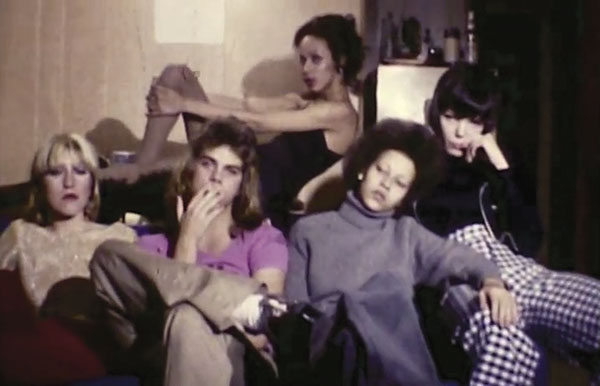
Mark Winer, As the World Burns, 1973, digitized super 8 film, 18:00 min. Courtesy of the artist. Presented simultaneously with Christian Walker: The Profane and the Poignant, As the World Burns: Queer Photography and Nightlife in Boston takes a deep dive into the photography of Boston’s queer scene from 1974 to 1984, corresponding with Walker’s time in the city. Defying genres, the exhibition unites fine art, instructional, vernacular, and documentary photography with experimental video and photographically derived textiles. Curated by Jackson Davidow, Ph.D., in collaboration with the TUAG curator, Laurel V. McLaughlin, the exhibition highlights a new presentation of photographically generated works formed from LGBTQ+ histories contextualized within Boston and its changing cityscape.
Upon entering, we follow Walker’s series The Theatre Project, a line of analog black and white prints diving into the cruising culture of the Pilgrim Theatre, the images reveal shifting scenes of lone figures dimly glimpsed and couples kissing. These photos set the exhibition tone–contemplative, passionate, considerate, and frank–often located on the streets of the Combat Zone, in nightclubs, and glancing in on intimate scenes.
On one wall, photographs highlight a single fashion show at Spit, a former nightclub on Lansdowne Street, where Gail Thacker, one of the performers, captured the excitement of readying for the night. The only depiction of the fashion show itself is Philip Phlash’s Mark Morrisroe, Pat Hearn and Friends, capturing the performers giddy on stage.
Images surround Mark Winer’s Super 8 film, after which the exhibition is named, As the World Burns (1973)–dreamlike and almost erotic, Winer envisions Bobby Busnach’s life as a hustler and others pictured throughout the exhibition. Haunting and hypnotizing, it is hard to look away, as music entices viewers into scenes of friendship intermingled with masturbation and sexually explicit flirtations.
Illuminating Boston’s unseen queer histories, As the World Burns expands the canon of the Boston School, first coined by Nan Goldin and solidified by Lia Gangitano and Milan Kalinovska’s exhibition The Boston School. As the World Burns expands this canon to include many previously unconsidered artists. Focusing on a single decade and inviting a new perspective on community, passion, and intimacy, Davidow unearths the history of LGBTQ+ artists in Boston.
— Abbi Kenny
- Fluid Matters, Grounded Bodies: Decolonizing Ecological Encounters
Gallery 360, Northeastern University, Boston, MA • camd.northeastern.edu/cfa/center-for-the-arts-exhibitions/ • Through April 6, 2024

Farah Al Qasimi, Um Al Naar (Mother of Fire), 2019. Digital video, 42 minutes and 7 seconds. Courtesy of the artist. Gallery 360, nestled into Northeastern University’s campus, presents this stand-out exhibition featuring artists Farah Al Qasimi, Beatriz Cortez, micha cárdenas, Tessa Grundon, Allison Janae Hamilton, Joiri Minaya, Ada M. Patterson, Wendy Red Star, Himali Singh Soin, Annie Sprinkle, and Beth Stephens. Originally presented at NYU’s Gallatin Galleries in July 2022, Northeastern’s team worked with the curators to re-envision the exhibition for Northeastern and Boston. The show spans two venues, Gallery 360 and Northeastern Crossing, a public-facing community-oriented initiative providing a space for students and residents. Aimed at deconstructing hierarchical and colonial narratives around climate change, this exhibition positions itself as a place for self-discovery and reflection on the current climate crisis.
Upon entering the corridor-like gallery sided by one long glass wall offering a view to passersby, we encounter Wendy Red Star’s collages from the series A Float for the Future (2021). Brightly colored fabric and images reimagine the Crow Fair Parade with an eye toward future potential. Arranged into four sections, the exhibition begins here with Counter-Histories and Mythologies of Place, then moves through Bodily Presence and Absence, Kinship as Remediation, and Beyond the Coloniality of Place.
One highlight is Farah Al Qasimi’s Um Al Naar (Mother of Fire). A 42-minute and 7-second video in a documentary-style reality TV format presenting a Jinn from Ras Al Khaimah, UAE. Through a combination of found footage and interviews in this strange and captivating video Al Qasimi explores local history, colonial history, myth, and issues of identity.
Throughout the exhibition, time becomes layered and compressed. Works like micha cárdenas’s Sin Sol/No Sun (2018) place the player in an augmented reality video game set in the year 2068, and Joiri Minaya’s collages combine historical and contemporary images of Dominican and Caribbean women and landscapes illuminating the legacy of colonialism.
In addition to community engagement spearheaded by Northeastern Crossing, an exhibition catalog will be available in early 2024. To be located in the gallery, the catalog will include three interviews with artists Cortez, Patterson, and Soin, providing visitors with an expanded view into the artworks and artist’s practices. This exhibition is an exceptional reason to visit and explore Northeastern’s campus.
— Abbi Kenny
- Radical Pots & Cooperative Hands: Katherine Choy and Clay Art Center
Greenwich Historical Society, Cos Cob, CT • greenwichhistory.org • Through February 4, 2024

Katherine Choy, ca. 1957, Pair of Bottles, left to right: Bottle with Donut Shape, stoneware, 9.5″; Long-Necked Footed Bottle with Thumb Hole, stoneware, 11″. Clay Art Center Collection. Photo: Paul Mutino. Radical Pots & Cooperative Hands: Katherine Choy and Clay Art Center is an exhibition that showcases the work of an incredible artist, as well as the stalwart community that she helped build.
Katherine Choy first came to America from China to attend college in 1946. By 1952, she had obtained bachelor’s and master’s degrees and became the head of the ceramics department at the Newcomb College at Tulane University. In 1957, she came into contact with Japanese-American potter Henry Okamoto, and soon after they founded Clay Art Center in Port Chester, NY. Tragically, Choy died of pneumonia at age thirty only one year later in 1958. Despite this hardship, Okamoto, the Port Chester community, and surrounding areas fought to keep Clay Art Center alive, and the nonprofit is a staple of the local arts community to this day.
Okamoto not only saved Clay Art Center after Choy’s untimely passing, he and the Clay Art Center staff also saved her work, notes, and her correspondence with Okamoto when the two were making plans for the Center. Many of these historical objects, including business documents, photographs and personal letters are on display alongside ceramic works by both Choy and Okamoto.
Choy’s ceramics are elegant, with great care shown towards delicate forms and complex glazing techniques, which were some of her specialties. Samples of Choy’s notes on and experiments with glazes are also on display. Around the time of her death, Choy was beginning to work on a larger scale as her pieces moved away from the functional and towards the purely aesthetic and sculptural. “They show that she’s trying to play around with surface and texture and thinking about basically making art that comments on its form and making,” remarked curator Maggie Dimock. Choy was talented and extremely prolific, as well. In the year she lived and worked in Port Chester alone, she created more than 200 pieces.
Greenwich Historical Society, with the help of Clay Art Center and other community partners, honors the legacy of a brilliant potter lost before her time and those who have kept that legacy alive for more than sixty years.
— Autumn Duke
- Totally Tubular
Tubular Times: Camp, Horror, and Music Television: Video Art 1981-1993 | Real Art Ways (Hartford, CT) | Through January 14, 2024

Possibly in MIchigan, 1983, Cecelia Condit, Courtesy Electronic Arts Intermix (EAI), New York. The parodic title of this delightfully indulgent and musically cantankerous group exhibition of new media art from the 80s and early 90s says it all—grab a pair of headphones, leave 2024 behind and dive in. Yet watchers beware: identity politics, capitalist ruination, mental illness, public trust, the cult of celebrity, natural disaster and feminist critique are just some of the themes that weave throughout the 300 minutes of footage, and eerily boomerang us back into the moment we’re living in.
The same could be said for the joyfully tubular experimentation in early video as a medium. Sampling, light filters, sound distortion, speed ramping, frame shots, scrolling captions and supranational live broadcast are just some of the special effects that recall our everyday contributions to social media posting. The narrators, much like today’s TikTok and IG users, are predominantly the artists themselves, self-cast as influencers, icons, talking heads, entertainers, documentarians and instigators.
The premise of Tubular Times is loose and wily. This is not a show that purports to comprehensively or conclusively represent a twelve-year window of video art. Really the commonality is a shared reverence and skepticism for television’s ever-growing presence within the American household. Given this curatorial freedom, many of the works have never been shown side by side before.
One surprising constellation features videos with strictly musical scripts. A Surrealist-inspired video by Cecilia Condit, which opens in a mall, tells the story of a woman with a chronically flawed love life. The original lyrics include the story of a poodle exploding in a microwave oven. Nearby, a rock opera by Michael Smith casts a contemporary light on the history of Manifest Destiny. Dressed as a cowboy mayor, Smith pitches real estate plans to win the town’s vote. Two TVs down, Dara Birnbaum manufactures a music video for Jimi Hendrix’s Fire!, which Hendrix never produced because the release predated MTV and the birth of the music video genre by fourteen years. The simple video features scenes from a fast food drive through, and cuts to a girl on a roofdeck drinking a beer from a glass.
The system articulated in Birnbaum’s film delivers the exhibition’s takeaway. We are on display. We put ourselves on display. We consume. We get consumed. As we cozy into the nostalgic moments of this show, this doesn’t mean we can’t long for simpler pre-internet times, when we crafted home movies in our basements with friends, or just knew less about breaking news around the world. It reminds us that we’re still deeply invested in the act of making images of ourselves to figure out just who we are, and where we’re located, in this given system, or the next to come.
-Sarah Fritchey
- Distant Visions: John Woolsey
Zillman Art Museum/University of Maine, Bangor, ME • zam.umaine.edu • Through December 30, 2023

Lazy S #1 (Mirrored), 2021, restructured woodcut, 25½ x 45″. Courtesy of the artist. “My work explores the concepts of time, breakdown, reordering and renewal in the environment,” writes John Woolsey in the catalogue for his solo show at the Zillman. The artist, who travels between Philadelphia and the Maine coast, offers nearly seventy pieces in oil, watercolor, acrylic, gouache, and woodcut—sometimes in layered and/or collaged combinations—that continue his dialogue with elements of the natural world, be it a forest floor, an estuary or a coral reef.
Woolsey traces this work, dating from 2018 to 2023, to drawings he made of ancient trees in temple gardens in Japan in 2010, in particular “root-scapes” formed by roots winding through moss. He transformed these and other sketches into sometimes dense compositions that might be called lyric abstractions, albeit with suggestions of the original subjects: leaves, plants, clouds, islands.
The complexity of pieces like the watercolors on woodcut Forest Floor #1 and Tondo #17 (Tide Pool #2) bring to mind the work of Alan Gussow and Emily Brown who found inspiration in similar subjects (including compost piles). Six vertical collages, a couple of them with jagged edges, underscore Woolsey’s sumptuous designs, edging into the decorative in the case of Spring Garden and Ripples.
Moving beyond the formal rectangle of earlier landscapes Woolsey explores a variety of engaging shapes, including fans, tondos, saw blades, a wave, and one he calls a “lazy S.” Arranged in groups on the museum walls, they form striking configurations.
Among the most recent work in the show is Reef, a stunning large (48 by 72 inches) oil. All manner of coral—brain, fan, finger—form a glowing underwater tapestry, unreal in its vivid coloration. Another 2023 oil, Delta, conjures the twisting arteries of water as seen perhaps from a satellite.
Woolsey is also showing at the Caldbeck Gallery in Rockland. John Woolsey: Time and Transformation (through November 4) features similar work, plus a group of earlier, more realistic landscapes, including some lovely pastels and gouaches of blueberry barrens, coastal ledges, and glacial erratics. Together, these shows provide exciting evidence of Woolsey’s ever-evolving vision.
— Carl Little
- The Brush and the Pixel
Fine Art Gallery, Colby-Sawyer College, New London, NH • colby-sawyer.edu/gallery • Through December 7, 2023
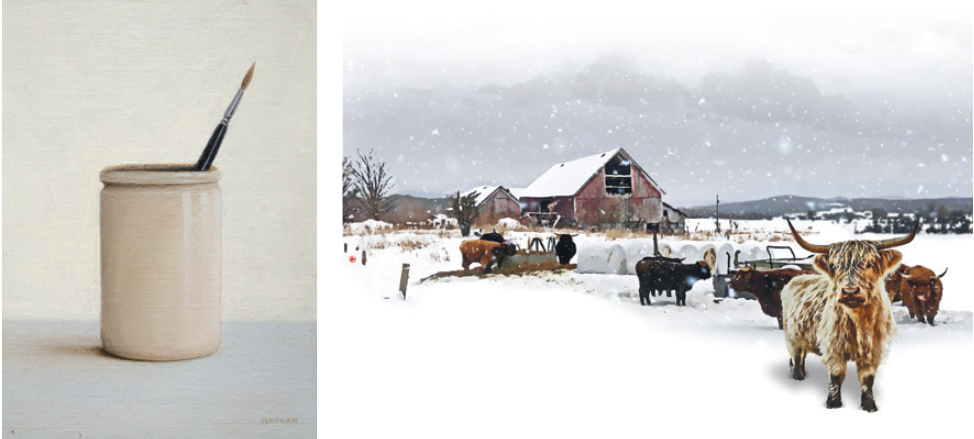
Above, from left: Peter Noonan, Brush in Jar, 2008, oil on linen on panel, 6 x 8″. Jack Tremblay, Winter Silence, 2023, digital composite, 40 x 27″. Courtesy of the artists. Depending where you stand in Colby-Sawyer College’s art gallery, there is an expansive mountain view competing with the artwork on the walls. The college sits on a hilltop in the Dartmouth-Lake Sunapee region, halfway between the state capital of Concord and the Ivy League town of Hanover—prime leaf-peeping country. The gallery is located in the nearly-new Davidow Center for Art and Design, a modern yet barn-like structure that complements the small campus’ historical architecture.
The Brush and the Pixel is the gallery’s latest exhibition, showcasing the work of two alumni: Peter Noonan and Jack Tremblay. Graduating one year apart from the college’s fine arts program, they have taken their art careers in very different directions.
Noonan is an illustrator, fine artist, and cartoonist who lives in Manchester, NH. His work on display includes editorial cartoons, caricatures, portraits, still-life and abstract paintings, and illustrations from his children’s book, The Bike Bus. A subtle still life (Brush in Jar, oil on linen on panel) is arresting in its Shaker-like simplicity, depicting a pale ceramic jar holding a single paintbrush. Noonan’s other paintings include a study for a water color portrait of the late Robert Stark that hangs in the New Hampshire State House. Also included are cartoons from the “Drawn and Quartered” series, inspired by political campaigns. “There’s never a shortage of material during the New Hampshire Primary,” the artist says.
Tremblay, an art director and corporate designer in northern Vermont, uses digital techniques. His works include abstract digital collages created with found, archival, and Creative Commons images. In some compositions, design, photography, and cultural appreciation coexist in one form. The exhibit includes Winter Silence, a snowy farm-scape complete with shaggy cattle. The scene is composed of ten separate images, then finished with hand details and mechanical color treatment features in Photoshop. The bull’s furry detail is done with a stylus and digital drawing pad. Tremblay (who describes his work as “unusual art for thoughtful people”), hopes his images “invite a laugh, a thoughtful pause, or a pondering stare.”
Colby-Sawyer College’s gallery is open when the school is in session. It is closed over the holiday break, re-opening in January with an exhibition of pieces selected from the permanent collection.
— Laurie D. Morrissey
- CONFLUX: LLOYD MARTIN + STEPHEN NICCOLLS
A guest curatorship by Jessica Hagen
Dryden Gallery/Providence Picture Frame, North Providence, RI • jessicahagen.com • Through December 2, 2023
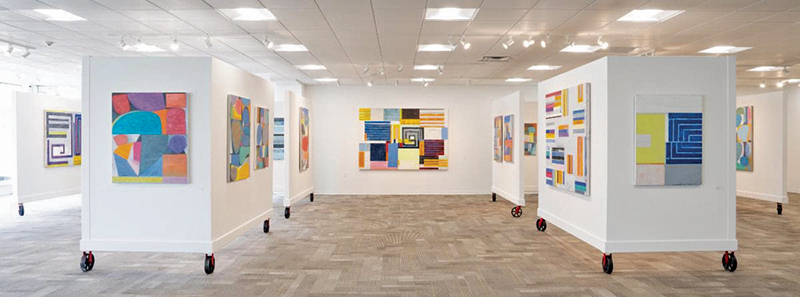
Installation view Conflux: Lloyd Martin + Stephen Niccolls. Photo: Dryden Gallery. The Dryden Gallery’s expansive exhibition space is the ideal venue for CONFLUX: LLOYD MARTIN + STEPHEN NICCOLLS, two accomplished, mid-career American artists. The exhibit includes forty-plus paintings, many large scale, and is presented by guest curator Jessica Hagen of Jessica Hagen Fine Art + Design of Newport, RI.
Hagen chose the name of the exhibition, CONFLUX, as it means a coming together, a confluence of Martin’s and Niccolls’ work. “To my eye, their paintings are a natural pairing,” says Hagen. “Both artists are highly skilled colorists creating compelling non-representational compositions. Martin’s work employs the use of straight lines to wrangle, define and convey areas of color, while Niccolls makes use of curvilinear shapes to do the same. The juxtaposition of these two stylistic approaches is exciting, uplifting, and energizing for the viewer.”
Martin is a Providence native and a graduate of the Rhode Island School of Design. Internationally recognized, his abstract work is often compared to music. Art critic John Goodman wrote that Martin’s paintings “achieve a Mondrianesque climax of rhythm.” The viewer perceives linear movement throughout his paintings and is expertly guided by Martin’s vibrant color juxtapositions. Furthermore, Martin references architecture in his paintings, though clearly abstract, that gives his work a sense of gravity and weight.
Niccolls hails from the Hudson Valley and received a BFA from the School of Fine Arts, Boston and an MFA from UMass Amherst. “Every sensation I’ve known can potentially find its way into my paintings,” says Niccolls, whose work arises from a fascination with structure. “Each painting establishes its own unique context, or world,” says Niccolls. “It may have elements that evoke still-life, landscape, or portrait painting, or some combination of any of these, or perhaps something else entirely.” Niccolls has exhibited extensively in museums and galleries throughout New York state and the northeast and is the recipient of the Phelan Award, the Purchase Award from the Samuel Dorsky Museum of Art, and the Albany Mayor’s Prize.
— Emily Randolph
- Gary Koeppel: Skyline
Inner Space Fine Arts, North Reading, MA • innerspace-fineart.com • November 4-December 16, 2023

Above, from left: Gary Koeppel, January 14, 2022, 5:47 p.m. and December 30, 2022, 5:46 p.m. oil on board, 12 x 26″. Courtesy of the artist. Inner Space Fine Arts opened its doors just a few weeks before the COVID-19 shutdown, in March 2020. While owner and director Allyson Paladino was planning for an uncertain future, artist Gary Koeppel was sitting in his Roslindale, MA, studio, gazing out his window at the everchanging Boston skyline. Although they didn’t know it yet, their paths would cross when the now-bustling Inner Space gallery agreed to show Koeppel’s work in Skyline this fall.
Koeppel was struck not just by the beauty of the skyline, but by the feelings it elicited. “There were so few people out on the roads at that time,” he shared. “There was that sense of isolation that I think we all felt, and I had a strong sense of that even looking out at this skyline.” Seeing Koeppel’s series does indeed conjure those feelings of distance and isolation that came with the 2020 shutdown. And yet, there is also a deep appreciation and love for the city that is made clear in the care he shows bringing it to life.
No two pieces in the series are the same, although each of them depicts the immutable shape of the city set against the innate changes of the natural sky. Two paintings based on photographs taken at almost exactly the same time, nearly a year apart, carry entirely different tones and colors. January 14, 2022, 5:47 p.m. is drenched in the familiar pink-and-orange light of a setting sun. A few colorful lights can be seen in the foreground where shadow has cast that part of town in early night. December 30, 2022, 5:46 p.m. is all blue and gray, except for the shining golds of the setting sun reflected against the skyscrapers.
Koeppel has been a working artist for more than forty years. He received his bachelor’s degree from the Maryland Institute College of Art, where he discovered a love for oil and plein air painting. He has been exhibited throughout New England and New York and has pieces in collections in the U.S. and Europe. “He has a painterly approach to the realism of a scene, and he gives it a sense of heart and spirit,” said Paladino.
— Autumn Duke
- Northwoods: Absence and Presence. The Art of Alan Bray and Poetry of Wesley McNair
Monson Arts Gallery, Monson, ME • monsonarts.org • Through October 29, 2023
In a 2009 talk connecting Edward Hopper’s art to literature, Harvard professor Peter Sacks offered various “analogues and oblique illuminations,” parallel aesthetics between his work and the verse of various poets, including Elizabeth Bishop and Robert Frost. This exhibition of paintings by Alan Bray and poems by Wesley McNair underscores that concept: no ekphrastic connection here, just kindred spirits.

Alan Bray, Cheese Factory Spring, 2007, casein on panel, 24 x 18″. Courtesy of the artist. By way of eighteen caseins, an oil, a giclée print and a drawing, and nineteen poems (from Late Wonders: New and Selected Poems, 2022), painter and poet present a Maine that lies not off the grid, but pretty close. And they know the territory well: Bray has lived in Sangerville for much of his life while McNair is a longtime resident of Mercer, both hamlets in the state’s hinterlands.
The pairings are inspired. McNair’s “In Praise of a Tree,” a tribute to an ancient white pine that has carried “cargoes of squirrels and song birds,” accompanies Bray’s Uprooted, 1994, a marvelously gnarly and surreal arboreal creation rimed with ice and snow.
Poet and artist make beauty out of the overlooked or unsung. Who could imagine a poem about telephone poles “balancing cables on their shoulders” might be transcendent in its vision? Bray’s Cheese Factory Spring, 2007, depicts a lost woodland watering hole; critic Edgar Allen Beem once called it “the apotheosis” of his “gnostic talent for evoking the hidden narrative of landscapes.”
In a statement for the show, McNair notes that his Maine “features people” while Bray’s “is largely without them.” That said, the individuals that appear in the poem “Seeing Mercer, Maine,” including “the old/man from the coast who built/the lobster shack/in a hayfield,” are kin to the folk who cut the slate that appears in Bray’s Hebron Quarry, 1980.
“Reading Wes’s poems or looking at Alan’s art,” writes curator Stuart Kestenbaum in the exhibition catalogue, “it’s clear…they have taken the time to examine the power of place—how we shape the land and it shapes us.” They also know how to shape our vision of a world through powerful poems and paintings.
— Carl Little
- Taking Place
HallSpace, Dorchester, MA • hallspace.org • Through October 21, 2023
Ellen Shattuck Pierce is a journalistic narrator in art. Her keen observations of her feelings and responses during the COVID pandemic and her experience as a public school teacher, mother, and artist inform the eighteen prints which comprise the Covid Chronicles which premier in the HallSpace exhibit. The works are a result of Shattuck Pierce’s 2022 Massachusetts Cultural Council Artist Fellowship.
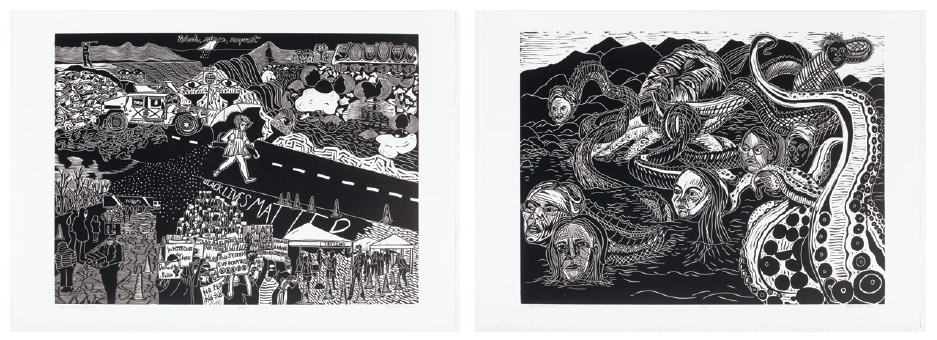
From left: Wash, Rinse, Repeat, 2020, relief cut, 18 x 24″. Circling Around, 2021, relief cut 18 x 24″. Photos: Will Howcroft. The tethering to the world wider than the personal is present throughout the series. In 4/13/20, a solitary woman staring out of her window is attached to a rope which wanders outside forming a heart that lassos universal symbols depicting populations and activities most threatened by COVID.
Replete with allegory, in Wash, Rinse, Repeat, an isolated child walks a proverbial “highway,” surrounded by scenes of people lined up for vaccines, for food, for Black Lives Matter protests. It is a stark presentation of what people could no longer pretend “not to see.”
Shattuck Pierce’s densely packed linotypes in relentless black and white emphasize the reduced quality of life visited upon all during the pandemic. In Reopening, which refers to the summer of hope in 2020, there is a sense of light permeating the usually dark palette. Winter Peril, which chronologically follows it, shows the return to isolation. Its figures appear mummified, wrapped once again by their constraints.
Circling Around shows off Shattuck Pierce’s masterful skills in creating motion through mark making. The endless spirals are almost dizzying as she references the vortex of emotion we felt as a nation on January 6, 2021, the day of the insurrection, with the Capitol encircled for weeks afterwards. Accompanying personal circles of solitary activities continued to mark every person’s day, measured by the rotation of a clock’s hands.
In an article she wrote, Bearing Witness, Pierce notes “All this is happening, all at the same time, and all of it is true.” The pandemic created a magnifying glass illuminating this ever-present reality. The series Covid Chronicles remains as a testament to a key moment in human history and a reminder of some of the lessons that we “perhaps” have learned.
— B. Amore
- Mickalene Thomas / Portrait of an Unlikely Space
Yale University Art Gallery, New Haven, CT • artgallery.yale.edu • Through January 7, 2024
This intriguing exhibition of small-scale portraits, from miniatures and daguerreotypes to silhouettes on paper and engravings in books of African-American women, men, and children from the pre-Emancipation era, was inspired by a palm-sized watercolor painting on ivory from the 1830s gifted in 2016 to the Yale University Art Gallery.
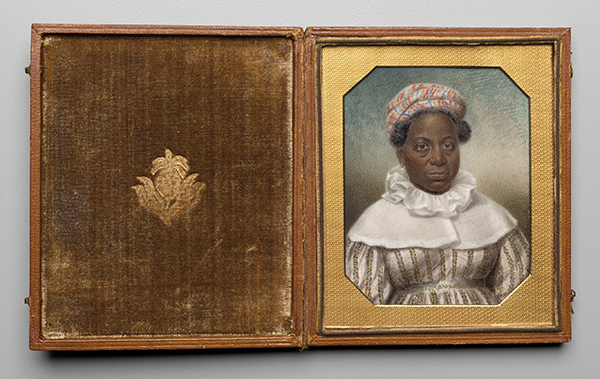
Sarah Goodridge, Rose Prentice (1771–1852), ca. 1837–38. Watercolor on ivory. Yale University Art Gallery, Partial gift of Caroline A. Phillips and purchased with the John Hill Morgan, b.a. 1893, ll.b. 1896, hon. 1929, Fund. The miniature depicts a formerly enslaved woman, Rose Prentice (1771–1852), painted by Sarah Goodridge (1788–1853), a largely self-taught artist whose miniatures, especially those painted on ivory, were sought-after and widely exhibited: Goodridge’s subjects included Daniel Webster and Gilbert Stuart. It is believed Prentice and Goodridge met when both were living in Boston.
“Prentice’s personal tribulations of enslavement, her decades-long labor as a domestic worker in white households, and the commission and ownership of her portrait by white patrons offer possible points of connection with the individuals pictured in the other historical objects on display,” according to Keely Orgeman, Yale’s associate curator of Modern and Contemporary Art and exhibition co-curator.
Portrait of an Unlikely Space is co-curated by internationally acclaimed artist/activist Mickalene Thomas (Yale M.F.A. 2002), the primary artistic contributor to this exhibition. Thomas is known for sumptuous paintings and photographic portraits of Black women as well as immersive, living-room style installations such as the one she is creating for Yale, which aims for the aura of a pre-Civil War interior. Complementary artworks, many incorporating the work of early-career artists of color, include sculpture, video and Thomas’ Polaroid photographs. “Our exhibition is a way of deepening the sense of interconnectedness among the stories of those who are included, whether as subjects or artists,” adds Orgeman.
“The meanings of Prentice’s portrait unfold the longer you sit with it, and that’s the kind of engagement I hope to facilitate with the other works, too, by enveloping them within transformed galleries where visitors will want to linger. I created my previous domestic settings primarily for fellow Black women—my ‘muses’—to spend time and have new experiences in familiar surroundings, perhaps resembling their mothers’ or grandmothers’ living rooms,” writes Thomas in the exhibition catalogue. “The sitters are my muses here. I dedicate this space to them.”
— Susan Rand Brown
- Alison Hildreth: Fifty Years; Late Summer: Alison Hildreth Prints and Drawings; Darkness Visible
Speedwell Projects, Portland, ME, speedwellprojects.com, Through December 22, 2023 • New Era Gallery, Vinalhaven, ME, neweragallery.com, Through October 11, 2023 • Center for Maine Contemporary Art, Rockland, ME, cmcanow.org, September 30, 2023–January 7, 2024
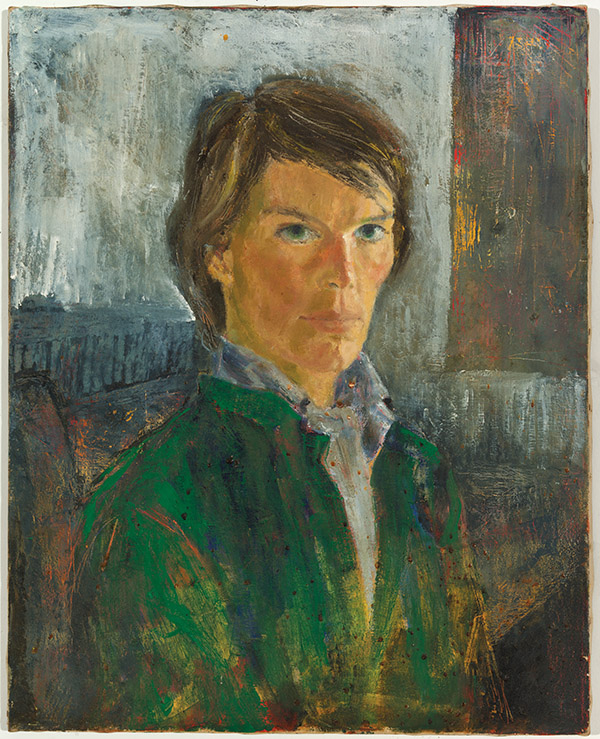
Self Portrait I, 1976, oil on canvas, 16 x 16″. Courtesy of the artist. Since she started showing her work in the 1970s, Alison Hildreth has never ceased to add admirers to her ever-compelling work—and to play a key role in Maine’s art scene as artist and advocate. Practicing in a range of mediums, including oil, ink, and various printmaking methods, Hildreth creates a universe where bats fill the evening sky, maps lead to new ancient lands, and beekeepers enact mysteries.
This fall, all the stops are being pulled out to celebrate Hildreth and her contributions to the art world. Each of three Maine venues is showing different aspects of her oeuvre with some overlap.
Speedwell Projects in Portland, where the artist maintains a space in the Bakery Studios, offers a mini-retrospective, including two self-portraits from 1976. In one, the painter looks squarely at us with a serious expression; in the other, more abstract rendering, she stands at her easel painting. These paintings and some others in the show have never been exhibited before.
Another painting in the Speedwell show, Beekeepers, features a fantastic vision of what might be a cave where Brueghel-like beehives frame a puppet show run by eleven disembodied blue hands. Black shapes are suspended by thin strips of paper with words on them. The whole scene has a Dante-esque feel to it.
New Era Gallery on Vinalhaven, an island Hildreth has frequented for decades, will present a group of twenty or so prints and drawings.
Several pieces feature one of her signature subjects, the bat. In her hands, this nocturnal mammal emerges in mid-flight, its wings broad and arched in air—the essence of motion.Other standouts in the New Era show are a lovely rendering of a dogwood blossom and two of Hildreth’s map works. Red Fort is an arrangement of coordinates and twisting arrowed lines superimposed on imaginary terrain while East features a molecular diagram set atop what look like plans for a fortress town and elaborate landscaped domains from an earlier century.
At the Center for Maine Contemporary Art, Hildreth is showing two bodies of work from recent, ongoing series. One of them features large aerial views of the earth painted on gampi paper made from the inner bark of a Japanese shrub. Hildreth studied landscape architecture in college and has never escaped, she writes in a statement for the show, “the idea of some form of map making.”
The other series reflects Hildreth’s fascination with the images arriving from the James Webb space telescope, photographs, she writes, of a “universe that we are a part of, a small blue planet in a vast and gorgeous and dangerous place.” Her oil paintings conjure the tumultuous edges of outer space and reflect her interest in “the complexity of life on earth and the relationships we have with the ecology of the planet.”

Flight #9, 2001, monoprint, 16 x 16″. Courtesy of New Era Gallery. Speedwell has recruited photographer and writer Smith Galtney to produce a documentary about Hildreth that will be shown during the exhibition. Additional special events are planned for the Portland Museum of Art and the Portland Public Library where Hildreth’s large-scale installation The Feathered Hand is on permanent display.
Suspended in the atrium The Feathered Hand is comprised of glass and plastic puppets, lenses, metal wire, sand, insects, and carborundum. The piece, which Hildreth says was inspired by her long-term interest in puppets, takes its name from a poem by Polish poet Zbigniew Herbert, “Chosen by the Stars,” which ends with the lines, “When he [the poet] has fallen all the way / he kicks with his legs / hangs for a moment / waving his feathered hand.”
“We believe that Alison Hildreth is a national treasure,” reads the Speedwell press release. On the basis of these three shows, that estimation rings true.
— Carl Little
- Barkley L. Hendricks in New London
Lyman Allyn Art Museum, New London, CT • lymanallyn.org • Through September 3, 2023
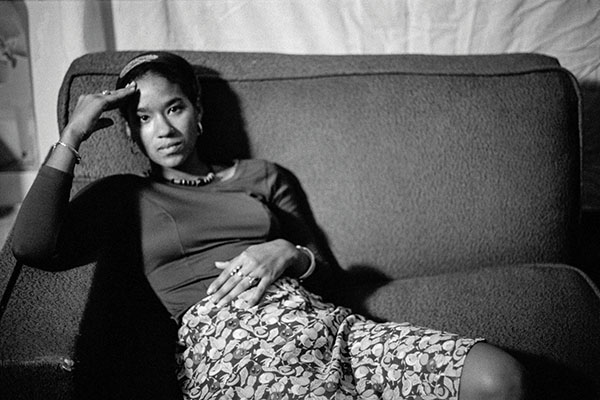
Barkley L. Hendricks, (American, 1945–2017), Untitled (Lynn Jenkins, New London), ca. 1975, gelatin silver print, 16 x 24″. © Barkley L. Hendricks. Courtesy of the Estate of Barkley L. Hendricks and Jack Shainman Gallery, New York. Friends, neighbors, former students, and colleagues turned out for the opening of the exhibition. For some, it was to pay homage to a masterful teacher who ruled with a demanding hand for close to 40 years at Connecticut College. For others, it was from remembering his large-scale hyper-realist portraits hanging in his downtown studio. Or perhaps they had encountered him on a city street with what he referred to as his “mechanical sketchbook.” Hendricks and his camera were out to catch snippets of life in this gritty city, and the exhibition is a marvelous starting point by which to consider the role of place, community, and teaching in Hendricks’ career.
Hendricks (1945–2017) died on the cusp of his ascendancy, and he perhaps would gasp at the news that one of his works just sold at auction for five million dollars or that an exhibition of his work will take center stage at Frick Madison in September. His photographs, which he often used as preparatory sketches, are highly valuable as well. Tanya Pohrt, who curated this thoughtful exhibition, selected 35 works by which to explore Hendricks’s regional story.
Hendricks studied at the Pennsylvania Academy of the Fine Arts and at Yale University before receiving his BA and MFA from Yale in 1972. The artist made life-size portraits of Black friends, relatives, and strangers—painting in the old master tradition, mindful that his interest in Black figuration in the 1960s and 1970s put him outside the mainstream of Black artists of that period. Floyd R. Thomas, Jr., suggested in an essay that Hendricks was the contemporary counterpart of “a West African griot who documents, preserves, and visually articulates the history of his people.”
And what an assortment—from young male fashion plates Hendricks encountered in Paris, to an ex-con he’d known when they were kids, stunning in a white-as-snow overcoat. His beautifully composed photographs, too, are full of life and character, whether it’s the saucy trio of sex workers, or the young boy at a local Fourth of July celebration whose smile lingers as a distillation of pure joy. Hendricks catches the patterns of a marching band’s shoes as well as the menacing visage of a white-robed KKK member at a rally in the early 1980s. Hendricks captured the good,
the bad, and the ugly, as well as the celebratory. — Kristin Nord - Eto Otitigbe, 2022 Saint-Gaudens Fellow
Saint-Gaudens National Historical Park, Cornish, NH • nps.gov • Through August 7, 2023
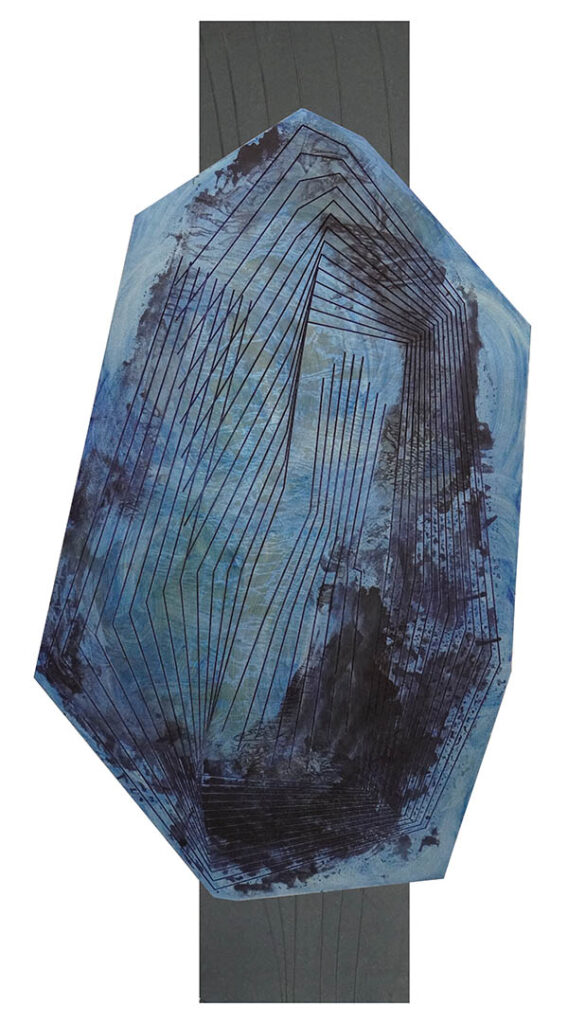
Blueprint for a Cosmic Mirror, Variant #1, 2023, aluminum plate, paint, Valchromat, 72 x 36 x 2″. Courtesy of the artist. The Saint-Gaudens Fellowship was launched in 1978 to provide financial support and exhibition opportunities to artists based primarily in the U.S. who are selected based on their exceptional exhibition record and the rigor of their work. The Fellowship is stewarded by the Saint-Gaudens Memorial, a non-profit organization housed on the grounds of Augustus Saint-Gaudens (1848–1907) home and studio in Cornish, NH. By promoting the work of contemporary American artists, the program links the legacy of Saint-Gaudens to current discourses in sculptural practice. The Fellowship culminates in an exhibition at the Saint-Gaudens Memorial each spring. Abra Ancliffe, exhibitions coordinator at Saint-Gaudens said, “Those of us at the Saint-Gaudens Memorial and the curatorial staff of the Saint-Gaudens National Historical Park support the artist’s vision and allow them to determine the scope of the exhibition.”
Fellow Eto Otitigbe’s exhibition opened this spring with a series of new works in Saint-Gaudens Picture Gallery. Otitigbe, a polymedia artist whose interdisciplinary practice includes sculpture, performance, installation, and public art, interrogates historical narratives and posits alternatives to conventional lines of thought through works that frequently combine sculpture, installation and new media.
Two new works, Okioso and Blueprint for a Cosmic Mirror, Variant #1, are installed in the East Room of the Picture Gallery, the primary exhibition space on the grounds. Okioso (2022) is a triptych on aluminum panels mounted to wood supports. The work, combining drawing, painting and assemblage techniques, features linear designs that resemble topographical diagrams. The designs are set against the luminous, variegated aluminum which give the piece an ethereal feeling.
In the West Room is Abandoned Orchestra (2021), a freestanding installation composed of hexagonal metal origami forms, organ pipes and a video projection with sound. This installation, in the center of the gallery, can be experienced in-the-round. Throughout his practice, Otitigbe extends the language of sculpture and imbues it with timely social commentary. His work is fresh and relevant to contemporary discourse, and activates the Beaux-Arts era venue in new and surprising ways.
As evidenced by this exhibition, the Saint-Gaudens Memorial Fellowship enriches the cultural landscape of New Hampshire’s Upper Valley by showcasing innovative contemporary artwork in this idyllic rural setting. — Eric Sutphin
- Nelson Stevens: Color Rapping
Springfield Museums, Springfield, MA • springfieldmuseums.org • Through September 3, 2023

Nelson Stevens (American, 1938–2022), Spirit Sister, 1971, acrylic on canvas. Collection of Christa & Michael Brinson. Photo: Greg Staley. Color Rapping, curated by Kiara Hill, celebrates Nelson Stevens’ fifty year career. The renowned artist, educator, and former Springfield resident influenced the art community as an early member of AfriCOBRA (the African Commune of Bad Relevant Artists). In his abstract expressionist works, he became a central figure in the Black Arts and Black Power movements while documenting the Black experience. In the early 1970s Stevens initiated a public art project in Springfield that made art accessible for those without access to museums. In over thirty murals throughout the city, Stevens’ promoted Black empowerment and gave way to a new movement which he dubbed Afro Kinetic Expressionism, a style that uses collage techniques to create images which give his works an almost three dimensional quality.
His figures, modeled after family and members of the community, replicate a stained glass that has been shattered, and then pieced back together. Enlisting geometric fragments, Stevens works breathe. His kaleidoscope compositions are represented in Heroic 1 and Spirit Sister. Over the years, Stevens immortalized figures such as Malcolm X, Stevie Wonder, Muhammad Ali, and Bob Marley. The artist, who passed in July 2022, used spray paint, colored pencils, airbrush techniques, and crayons to fashion this style he dubbed ‘color rapping.’
Stevens’ time in Springfield coincided with his tenure at the University of Massachusetts, Amherst, where he spent three decades teaching. One class was rooted in history and the other in figure drawing. Clyde Santan, a former student of Stevens, co-created The Wall of Black Music, a mural in Springfield. The piece, along with Tribute to Black Women, were recently recreated by Common Wealth Murals in honor of the late artist and were unveiled in October 2022.
In his early years, Stevens supported himself by painting murals in nightclubs in Utica, NY, where he would eat for free. Later, he taught at The Karamu House in Cleveland OH, the oldest Black producing theater in the country where his works are on permanent collection, as well as Kent State University, where the artist attended graduate school. Additional works are found in the permanent collections at The Smithsonian, Fisk University, The Chicago Institute of Art, and the Brooklyn Museum. — Jennifer Mancuso
- Nor’easter: Paintings by Terry Ekasala, Rick Harlow, and Craig Stockwell
The Bundy Modern, Waitsfield, VT • bundymodern.com • Through September 3, 2023
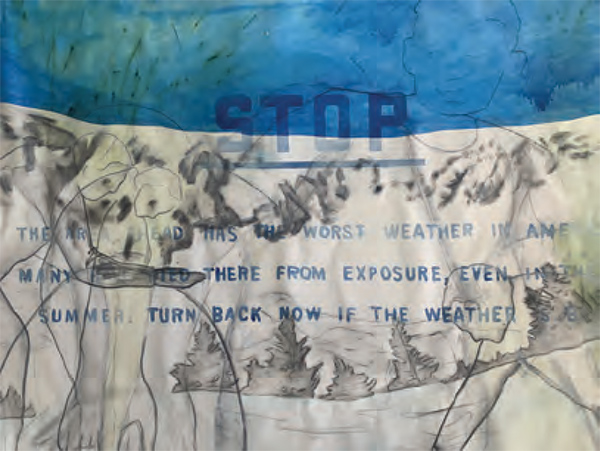
Craig Stockwell, Mt. Washington (memorial), 2022, oil on canvas and panels, 84 x 120″. Courtesy of the artist. Each year, locals and summer visitors flock to the Bundy Modern in Waitsfield, VT, greeted by art aficionados and owners/collectors Wendell and June Anderson. The Bundy Modern celebrates summer with a nod to an unforgettable yet classic New England experience—the nor’easter.
Nor’easter features work by established artists Terry Ekasala, Rick Harlow, and Craig Stockwell. Curator Richard Jacobs, who exhibited here in “Triad 2020,” he shares, “As artists, we relish any reason to stop in our tracks… and experience stillness. The reflections of light after a fresh snowfall create an optimal condition for alchemy in our studios to create deeper experiences with color, texture, and spatial illusion in our work.”
This collection of paintings offers an atmosphere of “otherness,” housed in the architectural gem of this International Movement gallery built on a sculpture garden. Energies of vibrating color, gesture and mapping of mountainous danger bring viewers to various points of emotion and contemplation.
Ekasala exhibits internationally as well as at the Hall Art Foundation and many other locations in Vermont. She is known for taking chances in her work—a master in layering semi-transparent abstract shapes in her compositions. Her gestures speak to the power of a nor’easter coupled with a magnificent palette.
Stockwell’s work in Nor’easter employs the perspective of mortality. Of his Mt. Washington (memorial) installation, he describes “The mountain is haunted…by all the deaths and being the one place in New England where the weather can suddenly force a climber to descend into real danger.” Merging drawing with painting, he reveals that other paintings in this installation explore “formal abstract relationships, mixing up formalist abstraction with dire narrative.”
Harlow has been working with native peoples in Columbia for the past 31 years—a strong influence in his work. On process, Harlow explains, “The paintings are created by splattering small drops of paint using a brush that I hit against a stick while painting on the floor.” A true colorist, his abstract works vibrate with an energy that envelops the viewer with the feeling of being in the eye of the storm. There is a sweet spot in looking at Harlow’s paintings where the color moves, shifting on the canvas—creating a hypnotic effect. — Kelly Holt
- Tony Sarg: Genius at Play
The Norman Rockwell Museum, Stockbridge MA • nrm.org • Through November 5, 2023
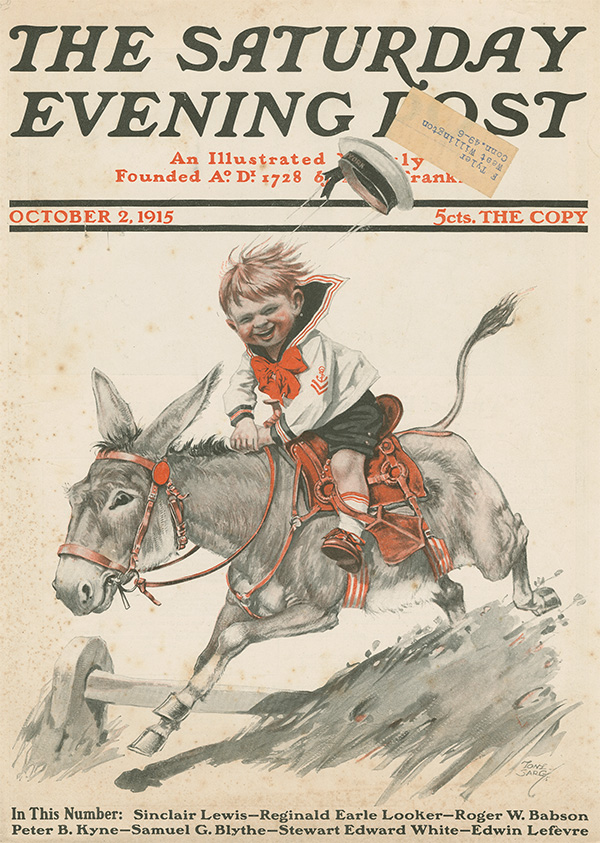
Riding the Donkey. Cover illustration for the Saturday Evening Post, October 2, 1915. Tear sheet. Collection of George Korn. Tony Sarg (1880–1942) was an advertising impresario who invested his artistic skills in a multitude of commercial enterprises during the 1920s and 30s. His illustrations ranked with those of Norman Rockwell. He was a leading graphic designer, a major promoter of puppet theater, and a pioneer in animation technology before the digital age.
Yet he is scarcely known today. “That’s because he over-extended his business ventures, fell into bankruptcy and died relatively young without an advocate to preserve his legacy,” explained the Rockwell’s Stephanie Haboush Plunkett, co-curator with Lenore D. Miller of the George Washington University Museum, of this colorful, richly diverse exhibition.
It’s aim, she said, “is to bring this important American artist and public figure to light for new generations.”
Born in Guatemala to a well-to-do German father and English mother, Sarg was schooled in Germany and moved to England in 1905 to pursue a career in illustration and study marionette theater. He married, fathered a daughter, and brought his family to the U.S. in 1915 after the start of WWI.
Settling in New York, Sarg became a U.S. citizen and amped up his already successful illustration and design work with marionette theater skills to bring animation to his commercial ventures, among them a national puppet touring company.
His signature achievement—the helium-filled, aerial floats of animals and pop culture figures created for the 1927 Macy’s Thanksgiving parade—still delight crowds. His top promotional stunt was to stage sea monster sightings in 1937 near his Nantucket summer home and shop to draw national press attention to the island. The “monster” was a former Macy’s float.
This exhibition, which moves to the Nantucket Historical Association next summer, captures the skill, energy and diversity of Sarg’s engaging accomplishments in three, tightly packed, deftly edited galleries. One introduces viewers to his early work; another focuses on his puppetry and book projects; a third looks at his large-scale achievements like the Macy’s parade and the sea monster hoax.
For an immigrant artist who helped define an era of American pop culture, the exhibition is a step toward renewed recognition.
— Charles Bonenti
- All Decked Out
Art for the Soul Gallery, Springfield, MA • artforthesoulgallery.com • June 10–September 10, 2023

Clockwise, from top left: Paul Goodnight, Untitled, 2022, painting on paper attached to board; Lourdes Morales, Untitled, 2023, acrylic on board; Madeline Williams, Life, 2023, acrylic on board; Ryan Murray, Jones, 2022, acrylic on board. All Decked Out celebrates skateboard decks reimagined into art. Art for the Soul Gallery championed the project in conjunction with its Transformational Arts and Culture Project. Honoring the legacy of the young skateboarder for which it is named, Gio’s Ollie Session is an endeavor funded by a Mass Development grant and a collaboration between the towns of Chicopee, Springfield, and Holyoke. The gateway city partnership promotes safety, advances inclusivity, and breaks down stigmas around skateboard culture.
In its second year, the grant was due in large part to the efforts of Art for the Soul Gallery owner, Rosemary Tracy Woods. Billy Myers, the Gallery’s artistic director, agrees. “We need to give one hundred percent credit to [Rosemary] Tracy… She wanted to include all of the cities surrounding Springfield.” In February 2022, Springfield’s Park Commission voted to build a new bike and skate park. Art for the Soul has hosted paint parties for young skateboarders along with safety gatherings.
The show will include roughly thirty artists. Anticipated submissions include John Longbow of the Choctaw and Chickasaw Nations who resides in New Mexico. Longbow designs guitars and is creating a stringed deck meant to be played. An artist himself, Myers is an art conservator specializing in period frames and altar pieces. His deck has been spliced in half to resemble an altar and mounted in a gold frame. “Some of these boards won’t even look like skateboards,” he says.
Artist Ryan Murray used the deck as a traditional canvas. “I’ve never worked on a skateboard before… I approached it the same way I would paint one of my vinyl records and just had fun with it, using a graffiti motif I was familiar with,” he says.
The exhibition coincides with Go Skate Date on June 21, 2023, and Theory Skate Shop, who provided the decks, plans to set up ramps and offer demonstrations.
“It’s time we changed people’s perceptions about skateboarding,” says Woods. After the exhibition, the works will be auctioned for a fundraiser. Other artists include: Paul Goodnight, Larry Poncho Brown, Dean Nimmer, Paul Midura, Nora Valdez, Marc Brown, Michael Tillyer, Anthony Melting Tallow, Peter Dellert, Scott Swan, and Richard Bulda.
— Jennifer Mancuso
- Nebizun: Water is Life
Bennington Museum, Bennington, VT • benningtonmuseum.org • Through July 16, 2023

Francine Poitras Jones (Nulhegan Abenaki), Water is Life, 2019, acrylic on canvas, 16 x 20”. Nebizun: Water is Life, is a “living, breathing exhibition,” curated by Vera Longtoe Sheehan, founder of the Abenaki Art Association. The exhibition brings together artists from four recognized tribes from the Champlain Valley and the Connecticut River Valley for its fourth stop on a two-year tour. Nebizun (Abenaki for medicine, whose root nebi means water) metamorphosizes in each curatorial iteration. A vital part of Abenaki art and culture is stewardship of the land, N’Dakinna (our homeland). Explains Sheehan, “The Abenaki people know how essential water is to foodways, medicine, and everyday activities that may be taken for granted.”
Many works are influenced by activist elders. Nebizun is inspired by Grandmother Doreen Bernard’s ‘water walk’ from Nova Scotia to Maine to pray for an abundance of water. Another inspiration is the Standing Rock crisis and art activism by Grandmother Willi Nolan: “Our waters are our highways.” Only Native American people were at Standing Rock—the word was spread via social media. No Pipelines, a drawing by artist JES, was created to share through those channels. Francine Poitras Jones’ Water is Life painting is a direct expression of this protest, “…it was my reality…the painting flowed from me, much like the water that sustains life.”
The exhibition takes visitors through several watershed topics while mirroring Abenaki making and way of life. Traversing a long space, each stop works like a tributary. The exhibition is peppered with water facts that will make you pause the next time you make a cup of coffee, and more. Another tributary begins with images of creation and Standing Rock, then flows into the importance of wetlands as protectors highlighting duck-decoys made from cattails, netmaking, fishing implements and birch, a vital material in canoe making and creating “biting patterns” in pieces of art. At one end of the space is an arresting photo of ancestral rock carvings—petroglyphs of the faces in Bellows Falls, VT. The installation continues with beading and pottery, and concludes with detailed maps, calls to activism, and digital paintings Across the River by Hawk Schulmeisters that evoke pollution in water.
— Kelly Holt
- Daisy Dew-diamond
Standard Space, Sharon, CT • standardspace.net • May 26–June 25, 2023

Louise Sheldon, Tablecloth Friend, 2022, watercolor on paper, 39¼ x 27¼” (99.4 x 68.9 cm). Nestled in a small, historic, quintessential Connecticut town, Standard Space Gallery is anything but standard. In the quiet, clean space of this intimate studio-gallery, a revolution is happening. Within that revolution, Louise Sheldon’s work has found itself a worthy temporary home.
Although owner and photographic artist Theo Coulombe did not intend to stay in Sharon when he left Brooklyn, he has carved out a space for himself and other artists who push boundaries. Without setting out to do so, Coulombe has established a gallery that places emphasis on under-represented voices in the art community and on art that speaks for itself. “I’m not a gallerist, I’m an artist who owns a gallery,” Coulombe told this writer. It is this emphasis on artists first and gallery politics second that leads him to collaborate and to use his space to elevate the art and voices of fellow artists.
Louise Sheldon’s upcoming show, Daisy Dew-diamond, is one such collaboration. Described by Coulombe as “psychedelic,” Sheldon’s work is full of captivating patterns, unbelievably vibrant watercolors, and visuals that leap off the paper. A unique color palette and repeating motifs draw
a clear line from one piece to the next. Once you have seen Sheldon’s art, you would recognize her style anywhere. With her use of faces and eyes, Sheldon’s work confronts you in a most literal way. The dynamic of viewer-subject is turned on its head as the observer becomes the observed.Tablecloth Friend engages the simple and recognizable checked pattern of a picnic tablecloth. The face of the friend is kind and understanding, surrounded by a hazy aura of glowing sunset orange. Silly Rules is one of the few pieces that does not contain a characteristic face. Instead, big contoured drips fall from the top of the paper and sunny flowers overlay a hypnotic series of concentric circles reminiscent of a ripple in the water. This piece is a culmination of the bright colors and youthful patterns present throughout Sheldon’s work.
Simultaneously modern and vintage in aesthetic, Sheldon’s art draws you into a world of childish whimsy that elicits a pang of nostalgia and seems to deposit you into a dreamscape where flowers and tablecloths have faces and all the rules are silly.
— Autumn Duke
- Sky Power: Beckoning Color
Provincetown Art Association and Museum, Provincetown, MA • paam.org • May 5–June 25, 2023

Sky Power, The Gift, 2016, oil on canvas, 24 x 30″. Photo: Kevin Thomas. Two thousand twenty-three continues to be memorable for Sky Power, who has lived and worked in Provincetown, MA, since 1976. She exhibits regularly at Berta Walker Gallery, Provincetown’s home to generations of creatives defining America’s oldest art colony. “Our connection is deep, as is our mutual love of art and color,” Power says of Berta Walker.
Her painting Our Changing Climate (2021) was recently selected for a Provincetown Art Association and Museum (PAAM) juried exhibition. A carefully balanced synthesis of abstract and figurative elements presents the outline of a cottage swirling in hues of blue, while waves of yellows and oranges pull from a distance. Dynamic brushy strokes, created with thinned oil paints, lend a symphonic quality to this masterwork.
And now her solo exhibit, Sky Power: Beckoning Color, is on view at PAAM. Christine McCarthy, PAAM’s chief executive officer and exhibit curator, says of Power’s diverse body of work, spanning five decades, “It is driven by strong composition and color-as-form, created in the language of abstraction. Influenced by Hans Hofmann’s students, Power’s paintings seek to show the connection between representational and abstract art.”
In The Tides of Provincetown: Pivotal Years in America’s Oldest Continuous Art Colony (2011) Alexander J. Noelle, assistant curator of European paintings and sculpture at the Cleveland Museum of Art, describes Power’s ties to the gravitational pull of the Outer Cape. “Drawn to locales with vast skies and violent seasonal shifts,” Noelle writes, “Power creates paintings that evoke the feeling of a storm on the sea or a burst of clouds in the sky. The rolling waves, veils of haze, and distant vistas of the Cape are powerful sources of aesthetic inspiration.”
The Gift (2016) offers abstraction with a touch of Surrealism, maintaining the lyricism, and translucent colors, of her animated style. “I consider myself a colorist,” Power says. “I dream and thrive in the light, the colors, and the infinite horizon of the Cape.” A white droplet dangles from a string poised on the tip of a gestural zip, while a blue ribbon flirts with cottony pink. For Power, it is a portal into a dream. “I feel my work bridges the gap between me and what is on the other side, the other world.”
— Susan Rand Brown
- TURN OF PHRASE: LANGUAGE AND TRANSLATION IN GLOBAL CONTEMPORARY ART
Bowdoin College Museum of Art Brunswick, ME Bowdoin.edu Through June 4, 2023
Many years ago, a trucker hat with a Jenny Holzer truism on it, “Protect Me From What I Want,” came into my possession. Donated to the local Ladies Aid Society the hat eventually found a new home atop the head of an elderly Maine islander, its pronouncement drawing smiles and questioning looks on the mailboat ride to Great Cranberry Island.
The pieces that make up “Turn of Phrase,” curator Sabrina Lin’s remarkable exhibition, use diverse means to deliver their messages. Some, like Barbara Kruger’s nine-piece photolithographic and silkscreen print Untitled (we will no longer be seen and not heard), 1985, aligns with Holzer’s direct messaging although the actual words combined with found images are rebus-like in their presentation. Kruger, too, wants to, as Lin puts it, call into question “what or who is not seen and or heard.”
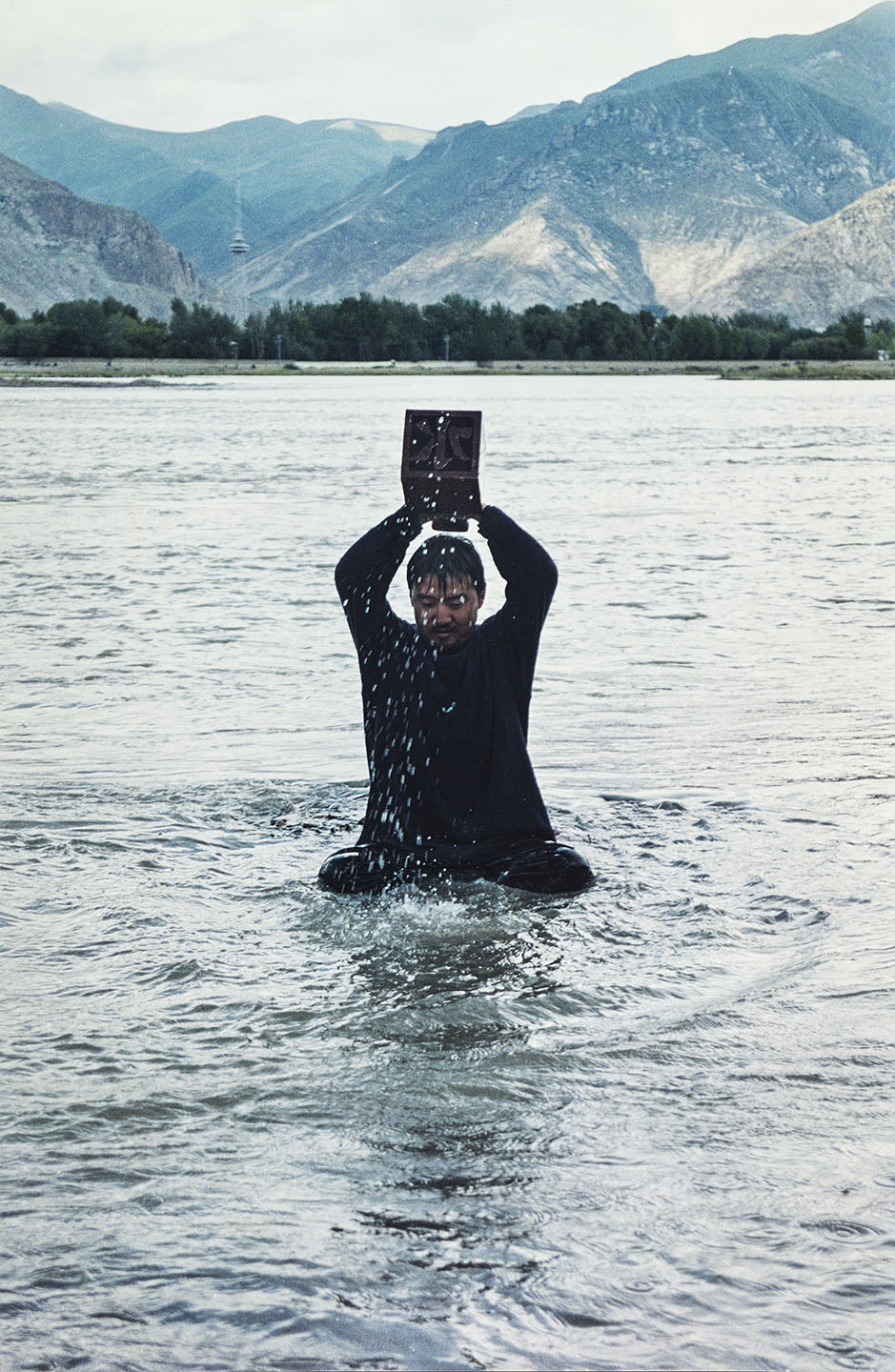
Song Dong 宋东, Stamping the Water (Yin shui 印水), (detail) 1996. From set of 36 digital color photographs. Gift of the Jack and Susy Wadsworth Collection of Contemporary Chinese Photographs, Jordan Schnitzer Museum of Art–University of Oregon. 2018:28.14a-aj. © Song Dong, courtesy Pace Gallery In some cases, the viewer must turn to Lin’s comprehensive catalogue essay to uncover the textual element. One example is Song Dong’s Stamping the Water, 1996, which consists of 36 still photographs from the artist’s hour-long performance in the Lhasa River in Tibet. While we can appreciate the stop-action images of Song lifting and slamming something in the water, when Lin relates that the object is a large wooden block carved with the Chinese character for “water,” a whole other level of understanding and admiration takes place. The existentialism of the act redoubles, Sisyphean in its repetition.
Lin’s guidance also comes in handy while studying Yanagi Yukinori’s Loves Me, Loves Me Not, 1997, a large wool carpet on jute backing with a semé of brass chrysanthemum petals. The curator explains how the lines of woven text represent the title’s phrase in languages related to Japan’s former colonies and the country’s indigenous populations. A gift to the Bowdoin Museum from the Marion Boulton “Kippy” Stroud Foundation, the piece was created in collaboration with the Fabric Workshop in Philadelphia.
The most disturbing piece in the show is Hung Liu’s Western Pass, 1990. The artist borrowed the principal image from a photograph taken during the Boxer Rebellion by British botanist Ernest Henry “Chinese” Wilson (1876-1930) showing two female prisoners hung crucifix-like on crude wooden easels about to be executed. The calligraphic poem in the middle, by Wang Wei (699-761 AD), “sensitively humanizes” the figures, writes Lin, who provides the translation: “Wait till we empty one more cup [of wine]—West of Yang Gate there’ll be no old friends.”
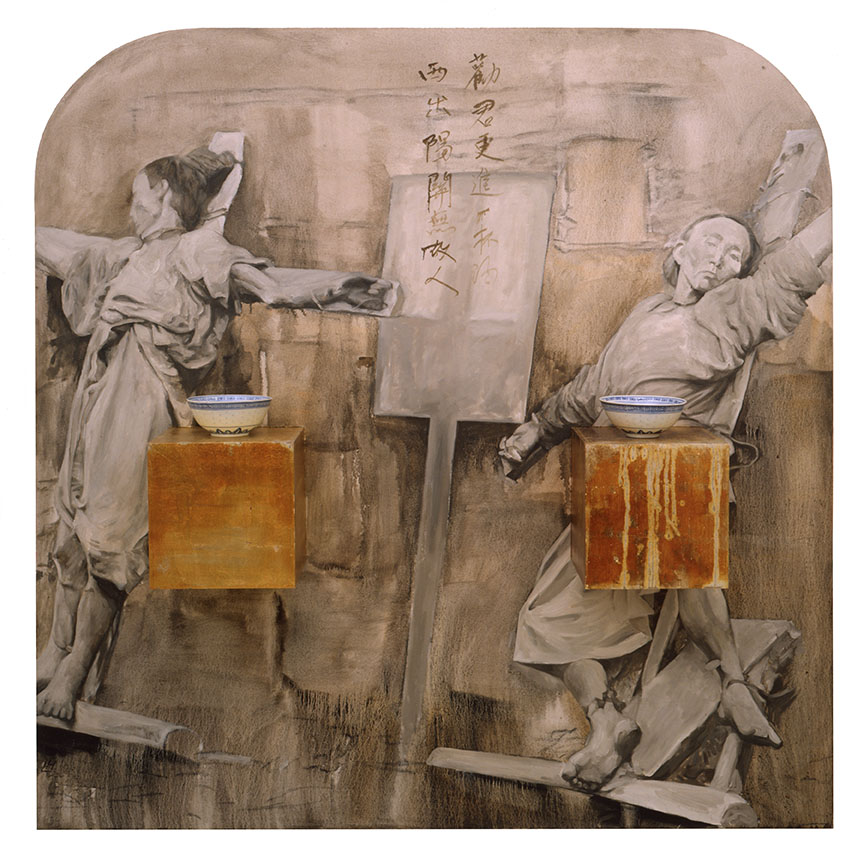
Hung Liu, Western Pass, 1990. Oil with silverleaf on wood, ceramics on canvas, 60 x 60 x 10 in. Bowdoin College Museum of Art, Museum Purchase, Lloyd O. and Marjorie Strong Coulter Fund, 2021.53. Courtesy Nancy Hoffman Gallery Lorna Simpson’s Waterbearer, 1986, and H.S., 1992, deploy language in different but equally forceful ways. In the former, a Black female figure, photographed with her back turned, empties a pitcher and plastic carton of water. Below her in block letters we read, “She saw him disappear by the river, / they asked her to tell what happened, / only to discount her memory.”
The sense of subjugated knowledge in Waterbearer carries over into H.S., a pair of dye diffusion color Polaroids showing a headless Black female figure holding a high school yearbook open to spreads of student headshots. You need to look closely to read the words “subjugation” and “indoctrination” inscribed repeatedly on the Plexiglas overlay. The vertical piece, nearly 50 inches tall, brings to mind ancient Greek caryatids but in this case the woman holds up not a building but a piece of charged personal history.
“Like art,” Lin writes at the beginning of her catalogue essay, “language acts as witness to societies and cultures, and becomes a mirror through which we see and situate ourselves in relation to the world.” Her selection, which includes work by Marta María Pérez Bravo, William Kentridge, Glenn Ligon, Qiu Zhijie, Meleko Mokgosi, Shirin Neshat, Wang Tiande, Xu Bing, Luis Camnitzer, and Jeffrey Gibson, highlights a compelling line of visual/textual works that continues today (see, for example, the recent work of Chloë Bass). Thanks to Lin’s deft and intriguing assemblage, we come away with a more nuanced view of how word and image may lead us to new understanding of disparate worlds.
–Carl Little
- LOOK UP: Skyscapes by Berta Burr
The Left Bank Gallery • North Bennington, VT • leftbankcalendar.org • Through January 31, 2023
In this noise-infested world, it is a balm to come upon Berta Burr’s serene series of sky portraits at Left Bank Gallery. This writer must disclose that he is a sucker for clouds, and did not find it hard to feel an affinity with the 26 paintings of varying sizes, some intimate (8 x 10″), and some expansive (30 x 40″). It also helps that Left Bank, as managed by artist Rhonda Ratray, is a perfect venue for a show of this scale as it is set in a former 19th-century bank with aged wood floors, direct lighting, large windows, and is a single space venue. From one point in the room, it seemed as if there were broken points of sky poking in, dropping tumbling bits of cotton.
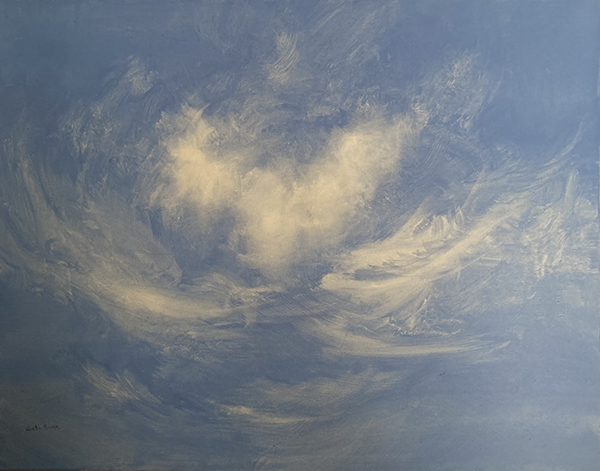
Berta Burr, Untitled #2, oil on canvas, 22 x 28″. Courtesy of Rhonda Ratray. Burr views the world “with a degree of detachment that allows for the possibility of beauty,” though I did not detect aloofness here. Burr’s eye is present, as is her hand, in the compositional choices and the modes of pigment application. What is there, for certain, is the beauty. The strength is in how she builds tension between the amorphous clouds, modeled, sculpted, and rendered as poetic beings set against the various shades of blue or crepuscular light: cerulean, azure, sapphire, arctic, or mustard, lilac, mango. Each view is a snapshot of a meteorological moment, a nod to Constable, and a gesture of respect for a part of the world under which we exist yet are often too frantic to notice. Burr’s imperative is that we “Look Up,” and when we do, as with her paintings, we will be pleasantly surprised, if not blessed.
The paintings are all untitled, allowing for freedom of interpretation, of self-labeling, of Wordsworthian immersion. Who does not want to wander within each of these windows? Clouds are merely water vapors, ice crystals, yet Burr sees beyond the scientific into the poetic. In Untitled 14, a flurry of darkened petals flows outward, a scumble of pigments, in a blue frame. In Untitled 15, Burr has arranged a combination of cirrus and stratus in a somber sky. The light play in each wisp indicates the emotional levels these heavens can assume.
This show connects to Constable, Debussy, and the Tang landscape painters, as it gives us a moment of peace, of magic, and of music, which amble on above, in a gentle and wise silence.
—Bret Chenkin
- Outsider Art: Harnessing Color
Jamestown Arts Center • Jamestown, RI • jamestownartcenter.org • January 27–April 1, 2023
Hasten spring’s arrival with a visit to Outsider Art: Harnessing Color at the Jamestown Arts Center. Co-curated by the art directors of the nonprofit Looking Upwards, Melissa Seitz, Vince Ruvolo, and Casey Weibust, the exhibition brings together “Outsider Art” commissioned and collected by organizations through the Northeast that work with artists with disabilities.

Robert Stengel (Out of the Box Studio & Gallery), Pennsylvania, watercolor on map, 15½ x 27″. The expansive galleries of the Jamestown Arts Center will be filled with work in all different media: from video to ceramics to canvas to bottlecaps, the exhibition promises to be dimensional and textured, utilizing all resources on hand. While Looking Upwards exhibitions in years prior focused on the technical frameworks of weaving and patterning, this year’s theme, Harnessing Color, was chosen in part as a balm to the depths of winter.
The center of the show will be the “wall of orange.” The six contributing organizations were tasked with either making new work or looking to their collections for works in orange to fill up the space, with the sensation of “walking into the sun,” says Weibust (Out of the Box, Jamestown, RI). She is especially excited about the collaborative installation; the works are pre-selected by the organization yet installed as an improvisational act, determining which works “play nicely” together—creating evocative connections rather than organizational ones.
An ”outsider artist” is one who hasn’t had conventional art education. A controversial term, this third iteration of the biennial event was entitled as such to draw connections with the annual Outsider Art Fair in New York, also in January, and to elicit conversation around its meaning. Seitz (Downtown Designs, Newport, RI) said “the thing I love about outsider art is that it’s often so exciting and surprising.” Outsider art often carries implications of naivete, but/and it can also circumvent the trends that seem to overdetermine contemporary art.
Of the biennial, Ruvolo (Studio 57, Middletown, RI) notes that it helps artists develop ongoing bodies of work, supporting their visibility and professionalization, and has aims to create (inter)national networks for artists with disabilities. Harnessing Color, especially, shows both the “joy of making and the joy of the maker.” This joy is contagious in discussing the plans for the opening and programming, which will include makers workshops and panels with artists and guests. Or, as Weibust pithily puts it: “Why not meet up and do something really fun and special?”
—Elizabeth Maynard
- Equals 6: A Sum Effect of Frank Bowling’s 5+1
University Hall Gallery, UMass Boston • Boston, MA • umb.edu • Through February 18, 2023
Frank Bowling’s Americas, currently on view at the Museum of Fine Arts, Boston, has a satellite exhibition at UMass Boston’s University Hall Gallery. The centerpiece of a multifaceted, collaborative project has as its starting point the landmark 1969 exhibition 5+1 at SUNY Stony Brook, which was curated by Bowling to spotlight the underrepresented abstract work of five Black artists and himself. The five, all men, were Melvin Edwards, Al Loving, Jack Whitten, Daniel LaRue Johnson, and William T. Williams. Equals 6 brings Bowling’s impulse into the present by featuring the varied work of women artists and Queer male artists—Dell Hamilton, Glenn Ligon, Steve Locke, Julie Mehretu, Destiny Palmer, and Howardena Pindell—and thus provides an edifying look at an expanded notion of abstract work today.
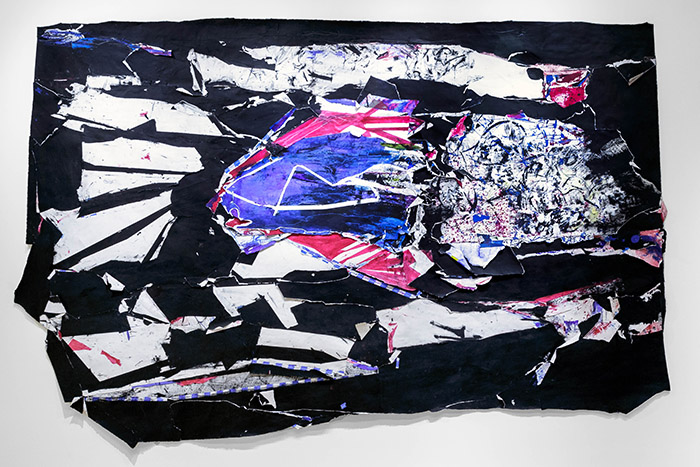
Dell Marie Hamilton, Systems Won’t Save Us, (Otherwise Known as Frankenstein), 2022, mixed-media on paper, 100 x 150″. Photo: Jon Bakos Photography. For example, in Homage to the Auction Block, Locke reworks Josef Albers’ pristine nesting squares and inserts the geometric shape of an auction block at the painting’s focal point. An exercise in color and contrast, it also conveys a message about slavery and oppression. Mehretu’s print, Slouching Towards Bethlehem (a title echoing both W. B. Yeats and Joan Didion), encompasses a whirl of anxious markings that suggests a fraught moment of discordant jazz…or conflicted humanity. An energetic, monumental sculptural drawing, Systems Won’t Save Us, (Otherwise Known as Frankenstein) by Dell Hamilton bursts forth to proclaim the center won’t hold, the systematic solutions won’t work, and that as a person who is neuro divergent she won’t assimilate. In the 12-minute, scripted video Free, White and 21, the well-known abstract artist (and SUNY Stony Brook professor) Howardena Pindell recounts her searing experiences of racism as a young Black woman.
As a means for the MFA to further expand its community connections and audiences, the laudable project, which includes an online component, enabled a small group of UMass Boston students to participate in the research and curatorial process. “Connecting our students with these artists and curators” says gallery director Samuel Toabe, “has given them agency within these institutions. We want to show them that, like Bowling, they too can subvert the art historical discourses around abstraction and representation by asserting their voices and getting involved.”
—Jack Curtis
- Sargent, Whistler & Venetian Glass: American Artists and the Magic of Murano
Mystic Seaport Museum • Mystic, CT • mysticseaport.org • Through February 27, 2023
Among over 115 artworks on view at Mystic Seaport Museum’s exhibition Sargent, Whistler & Venetian Glass sits Murano, Hermann Dudley Murphy’s 1907-dated painting of the titular island off of Venice, plunged into an impossibly thick wash of fog. Rendered in an emblematic blue that both signals nocturnal dimness and morning’s luminosity, the seascape veils the island of incomparable glass mastery with a malleability not indifferent from molten lava’s pliable nature during its metamorphosis into rigid glass.

Maurice Brazil Prendergast (1858–1924), Fiesta Grand Canal, Venice, ca. 1899, glass and ceramic mosaic tiles in plaster, 11 x 23″ (27.9 x 58.4 cm). Williams College Museum of Art, Bequest of Mrs. Charles Prendergast, 95.4.79. Courtesy of Mystic Seaport Museum. The exhibition, which features paintings, drawings, and prints, in addition to glass objects, assumes the late 19th century American artists’ fascination for Murano glassmaking tradition to explore the formation of mobility, cultural exchange, patronage, and art commerce among the era’s intelligentsia. In doing so, the juxtapositions of flamboyant Venetian canals, locals in idyllic postures, and ornate glass vessels—blown by Murano masters such as Giuseppe Barovier or Toso Brothers and collected by Americans—chronicle the blossoming of an American art determined to carve its global footprint whilst looking up to Europe for criteria of aesthetic and inspiration.
John Singer Sargent, who was in fact born in Florence to American parents, commences the show with a 1913-dated, lucidly-illustrated oil painting of Church of San Stae in which the building’s marble facade is washed with a dramatic veneer of sunlight and shadow. La Serenissima’s aquatic marvel inspired Maurice Brazil Prendergast both in canvas and glass. The Canadian born painter’s one-year-and-a-half sojourn in the Queen of the Adriatic in 1898 yielded two renditions of Venetians walking on the Riva degli Schiavoni with brightly-colored parasols. In the oil painting, circular umbrellas dot the crossing while the passersby in lavish dresses march toward a line of cafes facing the St. Mark’s Basin. The bird’s-eye view is rather abstracted in its glass and ceramic mosaic tile adaptation (1899) with a medley of rounded and geometric bits: umbrellas are minimized into densely arranged circles, blended with brown or blue rectangular tiles reminiscing the cobblestones and the sea that blanket the city. The sun that illuminates the water filling the canals finds a similar echo in glass when the light hits the blue mosaics in a similar gleam.
—Osman Can Yerebakan
- Amendment XXIX Right To Privacy
Canal Street Gallery • Bellows Falls, VT • canalstreetartgallery.com • Through December 10, 2022
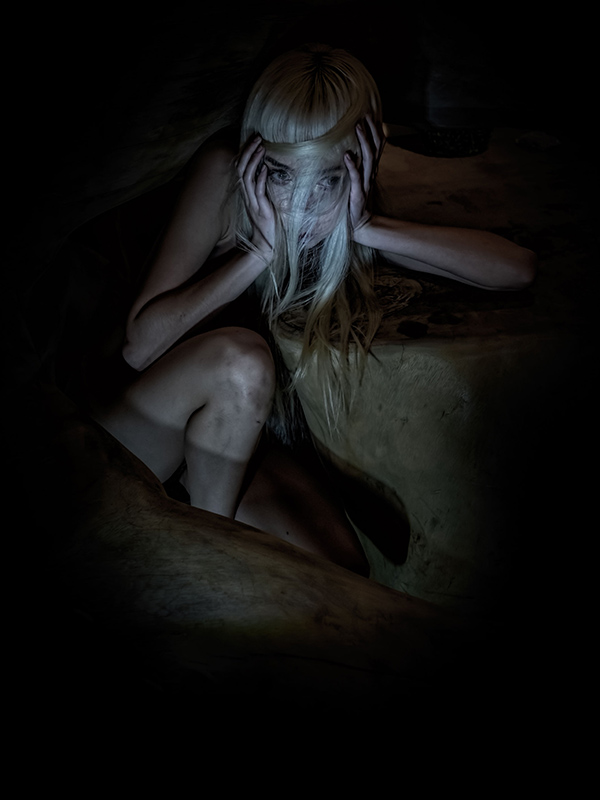
Yvette Hendler, There’s No Place Like Home, 2019, archival luster pigment print. These times try people’s souls. Michael Noyes, co-founder of Canal Street Gallery, curates an antidote to this intrusion by highlighting privacy in The Amendment XXIX Right to Privacy, featuring regional artists, including Clare Adams, Nancy Fitz-Rapalje, Corinne Greenhalgh, Yevette Hendler, Roxy Rubell, and Jeanette Staley.
Noyes feels “the ‘implied’ right to privacy in the Constitution relied upon by the Supreme Court for nearly 50 years is not enough. A new Amendment must be proposed to define the American citizen’s right to privacy, and to protect these rights.” He believes that an individual’s privacy is enshrined. In response, Adams venerates Supreme Court Justice Ruth Bader Ginsberg in a rectangular portrait of colored glass. Justice Ginsberg faces us center stage as an icon, set in crimson, cloaked in black, and surrounded by a blue and white border. This hagiography makes sense as stained glass evokes religious tradition. Who better to idolize than Ginsberg.
Playing up to the Kafka-esque cyber invasion of our lives with ironic wit is Hendler’s There’s No Place Like Home. Hendler quips that all this prying into people’s homes is enough to “motivate [us] to dwell in a remote cave.” She created a self-portrait of herself crouched in a rocky space, clasping her ears. An ominous light flashes upon her face, saying—“We got you!”
Some artists defend women’s freedoms. Fitz-Rapalje painted a line of women a la “The Handmaid’s Tale.” They solemnly stand in A Grievous Disregard, Violated Virgins Carrying Unwanted Children. As she explains, “it calls to mind one of the ways Dobbs v. Jackson infringes on a woman’s elemental privacy.” The Biblical pall over these costumes, and the reference to virgins, emphasizes the implications of governmental misogyny. Joining in the solidarity of guerilla artists like Chicago, Kruger, and Ringgold is Greenhalgh’s embroidered linen. Green-halgh sews text into kerchiefs—transforming traditional women’s objects into powerful talismans. Her piece Get It In Your Head Women Are Not Going Back To The Nineteen Fifties, exemplifies the general tenor of the show.
Staley’s American Red Fox, 2022 at 20 x 30″ offers an appropriate conclusion. This collage of an Audubon fox and Chinese motifs alludes to things being trapped. Yet the fox is snapping back, as must we all.
—Bret Chenkin
- Mariana Ramos Ortiz: Contra viento y marea
Central Contemporary Arts • Providence, RI • centralcontemporaryarts.org • Through December 8, 2022
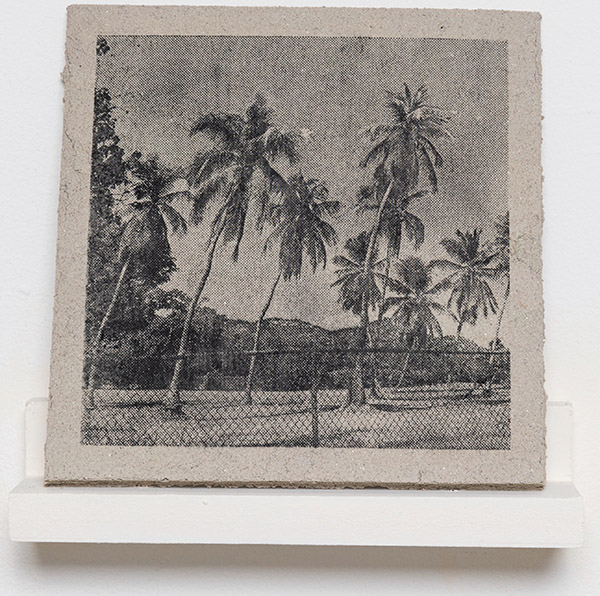
Mariana Ramos Ortiz, Caña Gorda, 2022, screenprint on sand, 8 x 8″. Courtesy of the artist. Even the title of Mariana Ramos Ortiz’s debut exhibition at the newly opened Central Contemporary Arts evokes a clever precarity, one of the threads elegantly woven through her exhibition of (un)familiar forms in sculpture, print, and video. Contra viento y marea literally evokes their medium of sand, subject to both wind and tide, and idiomatically calls for resistance against seemingly unstoppable forces. Ramos Ortiz’s semi-permanent works conjure fantasies of Puerto Rico in order to crumble them.
Absent are the azure blues of a tropical paradise. We are not welcomed onto white sand beaches, but are asked to consider the literal and poetic metaphors of sand—an oft-contested material in coastal economies. For instance, without a fixing agent, the cast-sand Breezeblocks (verja) doesn’t possess the protective function of their concrete, hurricane-resistant namesake. Their sturdy form belies their fragility, while also recalling the indelible presence of colonialism, as in this architectural reference to mid-century modern U.S. design and material, visible in sites such as Levittown, PR, built in 1963; Ramos Ortiz’s significations are multiple. Similarly, the sandbox constructions of Playgrounds refer to the exploitation of the island as a “taxless playground of the rich.” The photograph printed on the sand depicts the artist’s hometown of Cabo Rojo. In this material format, the landscape is imagined both as vulnerable to shifting conditions yet protected from touristic intrusions. For all the installations’ precarity, the artist continually returns to themes and forms of protection, or as co-curator Melaine Ferdinand-King writes of the Tormenteras, “[t]he hurricane storm shutters…offer a reading of the tropics that reflect its constant fluctuation between fragility and strength…and affirm everyday materials as sites of resistance.” Ramos Ortiz invites us to embody her fluency in conceptual materiality in La Peregrina, a massive ouroboros of a sand-hopscotch board, where we are invited to play, to fail, to resist, and re-signify.
At the time of the show’s opening, Puerto Rico is in the direct aftermath of Hurricane Fiona, impacted just before the fifth anniversary of Hurricane Maria. The legacies of colonial exploitation which leave the island vulnerable to increasingly frequent climate disasters make all the more urgent such explorations of futurity, as Ramos Ortiz deftly shapes and reshapes.
—Elizabeth Maynard
- Robin Tost: Scrap Metal Quilts
Cahoon Museum of American Art • Cotuit, MA • cahoonmuseum.org • Through December 23, 2022

Robin Tost, Spirit Bear, 2020, mixed metal and wire. Robin Tost is a dedicated practitioner of re-cycling and re-creating, as fully evidenced in her exhibition, Scrap Metal Quilts, at the Cahoon Museum of American Art. Western Massachusets-based Tost collects—you name it—automotive scrap, gutters, shed tin, tin cans, advertising signs, and other found materials from roadsides, transfer stations, and scrapyards; cuts them by hand into “patches” to be fit into a quilt design, traditional or free form; and uses a drill press to punch precise holes into the patches. Then she sews the pieces together with wire. The results are wonderful.
The works range from her first full-metal quilt, Rust (2008), her paean to corrosion comprised of pulls, grates, and tools plus washers, wires, and screens, to Kubo Totem, a fierce copper-tinged icon, created for this show, offset by scintillating Klimt-like gold and silver disks and squares.
For Crazy Quilt, which diverges from traditional quilt patterns, Tost designed each square individually and then assembled them into a captivating, dizzying layout. Each of the 63 squares would please a lover of abstract expressionism.
Some works are representational, such as Winter Sunrise, with striated gutters that resemble birch trees, while others are evocative, such as Fountain, with its flowing patchwork of many blues. Also on view, a few assemblages made of found objects of wood and metal, including the whimsical Trojan Chicken—on metal wheels.
Tost has recently transformed her flat quilts into large, more realistic, 3-D creations. Spirit Bear, arrayed in white, silver, and icy blues patches, is Tost’s salute to the mythic white bear. Her exuberant Phoenix ascends from a side lawn of the museum, while fanciful Cecilia, a giant sea serpent, slithers through the museum’s front lawn. All three statues have enjoyed stays at The Mount’s annual SculptureNow exhibition in Lenox, MA.
Found art and refuse transformed into art have always prompted viewers to see anew the things and materials that comprise our quotidian lives—and overload our landfills. To reframe an old adage, “Junk is beautiful in the eye of the beholder.” Here we are the fortunate witnesses to Tost’s masterful fashioning of the discarded into the magical.
Plus, on view from November 9–December 2022, Andrea Moore: An American Artist and Her English Garden and Pauline Lim: Travels in My Armchair.
—Jack Curtis
- Gladys Triana: A Path to Enlightenment 1971–2021
University of Saint Joseph and Fairfield University Art Museum • West Hartford, CT and Fairfield, CT • usj.edu and fairfield.edu • Through December 17, 2022
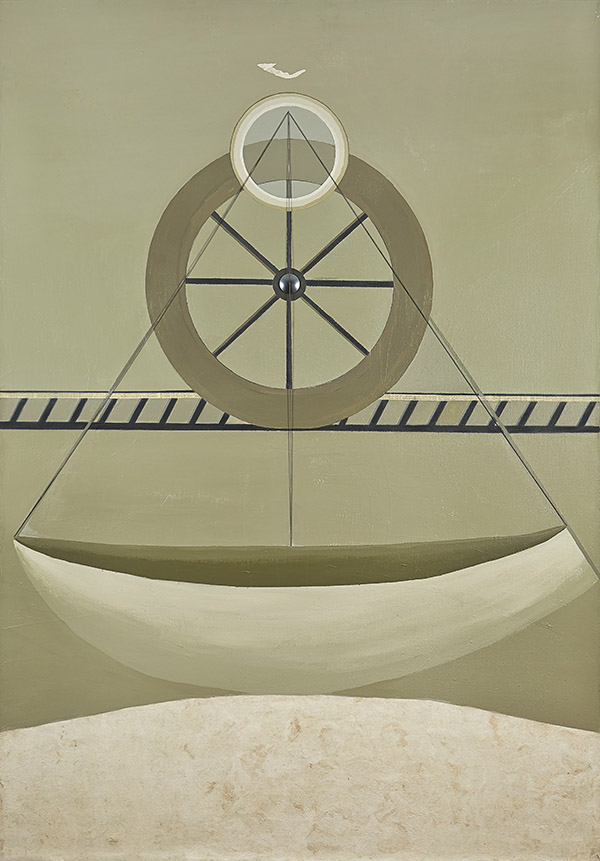
Gladys Triana, Nautical Rose, 1998, mixed media on canvas. Courtesy of the artist. © Gladys Triana. In 1984, Gladys Triana ripped up charcoal, pastel, and tempera drawings, many based on portraits of her Cuban-born family—a diaspora living in three countries at that time. In this physical and psychically ritualized act, she demarcated her practice: “I looked at them and said: this is not the work. The work is what I’m going to make of them.” Featuring an unsettling visage, the large-scale collage Homage to Munch (The Scream) is made from those drawings and is on view in Gladys Triana: A Path to Enlightenment 1971–2021. In the catalog, Adriana Herrera Téllez writes that Homage to Munch “establishes a paradigm for Triana’s aesthetic ruptures: it is the beginning of a long series of works, and it is a cry of expressive freedom….”
Throughout this two-venue survey, we see Triana’s “aesthetic ruptures” at play as she adds diverse media to her paintings—lace, stock market indexes clipped from the The New York Times, wooden dowels—and explores installation, sculpture, photography, and video. Named Beyond Exile at Fairfield and From the Female to the Intimate at Hartford, each venue distinctly frames her work, yet both include pieces from every era of Triana’s career and attend intersectionally to the Cuban-born, New York City-based artist’s life experiences; the influence of her studies in philosophy; the incorporation of feminism, especially relating to the body; and her spirituality.
This writer found Triana’s paintings and installations from the 1990s to be the strongest; however, her entire oeuvre is striking for its risk taking, its unexpected and elegant materiality, and in the paintings, its confident brushwork and refined sense of color. Two works that exude these qualities are The Path of Memory (1995), which addresses immigration, time, and exile; and the painting Nautical Rose (1998), a brilliant minimalist redux of Cuba’s iconic “Virgin of Charity” image. It is key to visit A Path to Enlightenment in person if one is to fully comprehend Triana’s subtle, yet dynamic, color palette, attention to surface, and voluminous scope and scale. Experienced in the galleries, the individual works become more than the sum of their parts—they become what we make of them.
—Terri C Smith
- 52 Artists: A Feminist Milestone
The Aldrich Contemporary Art Museum • Ridgefield, CT • thealdrich.org • Through January 8, 2023
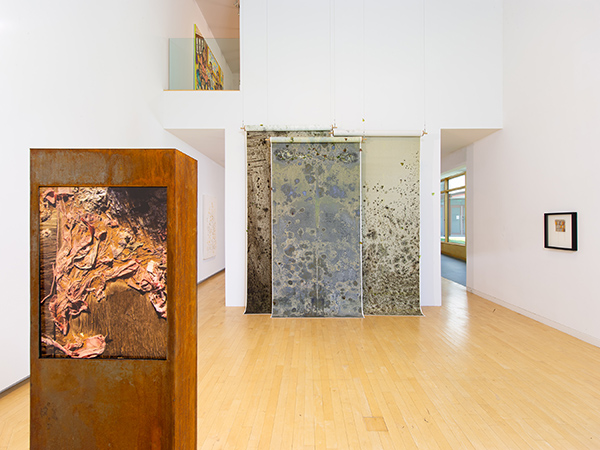
52 Artists: A Feminist Milestone (installation view). Photo: Jason Mandella. Strong research, diverse artistic practices, and animated feminist inquiry bridge two group exhibitions that were curated 51 years apart at The Aldrich—the historic Twenty Six Contemporary Women Artists, organized by pioneering curator, activist, and writer Lucy Lippard in 1971; and 52 Artists: A Feminist Milestone, an intergenerational homage and contemporary extension of Lippard’s show that adds 26 artists who are born after 1980, identify as female or nonbinary, and are influenced by feminist art practices. Curated by Alexandra Schwartz and Amy Smith-Stewart, 52 Artists presents works by all but three of the participants from the 1971 show alongside new artists whose inclusion “underscore[s] the original exhibition’s enduring legacy.” In 52 Artists, each gallery is a heartfelt homage to second-generation feminist artists—whose works appear shoulder-to-shoulder with their younger peers—and a bellwether for understanding contemporary ideas around gender identity and intersectional feminism.
Since some of the works from Twenty Six Contemporary Women Artists could not be located or were made using ephemeral materials, 52 Artists includes a mix—works from the original show, commissioned recreations, photo documentation, and representative pieces made by those artists in the late 1960s/early 1970s. Importantly, the exhibition often includes more recent works by these artists, showing how their art has changed over the years. The new generation of exhibiting artists has an equally diverse range of approaches and materials, yet are more international and more diverse in terms of race, sexual orientation, and gender identity. While the works from Twenty Six Contemporary Women Artists barely tackled political topics, the art by these younger artists frequently addresses politically charged themes, exploring Black queerness, transgender imagination, ableism, the Asian Diaspora, immigrant identities, cultural appropriation, and more.
In the galleries, the curators draw connections within and across generations using subject matter (the figure, the environment, marriage), materials (earth art, textiles, soft sculpture, assemblage), and tone (dystopic, celebratory, indexical). Their attention to the visitor’s phenomenological experience—the body moving from artwork to artwork and room to room—make 52 Artists as viscerally and visually engaging as it is rigorous and historically important. It is—to quote a phrase from Grace Glueck’s 1971 review of Twenty Six Contemporary Women Artists—“well worth the trip to Ridgefield.”
—Terri C Smith - Many Americas: Art Meets History
Southern Vermont Arts Center • Manchester, VT • svac.org • Through November 27, 2022
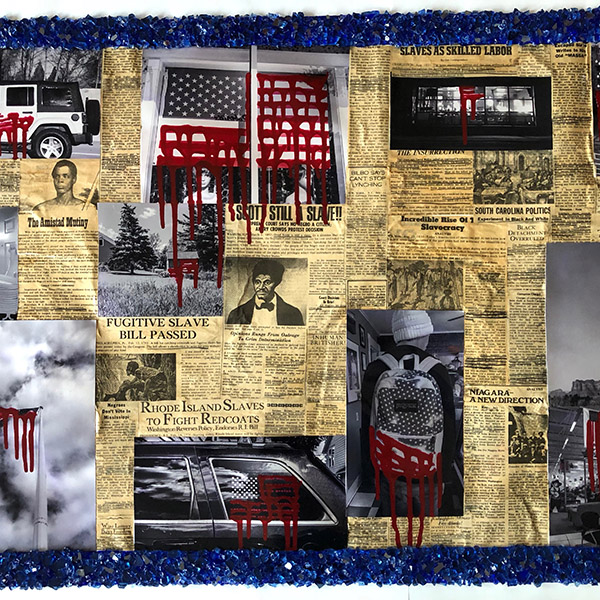
CoCo Harris, We Pledge Allegiance (detail), 2022, photographs (metallic paper), acrylic, archived newspaper clippings, archival ink, high gloss varnish, unstretched canvas, shards of broken mirrored blue glass, 25 x 108 x .25″. Despite America’s historic designation as a “melting pot,” this exhibit puts forth the theory that “we do not share a common history, and as a result, our divergent histories are the source of our troubled public discourse.” Guest curator Ric Kasini Kadour developed Many Americas: Art Meets History with SVAC during an eighteen-month-long research project funded by the Andy Warhol Foundation for the Visual Arts. Warhol himself would no doubt be pleased with the complexity and variety of the works presented.
We Pledge Allegiance by CoCo Harris, a monumental 3-foot by 10-foot collage, combines historical news clipping from The Black Chronicle and photographs of the American flag, often dripping blood. The yellowed newspaper behind the images is an inescapable testament to the history of racism in America. Nell Irvin Painter’s You say This Can’t really Be America, graphically illustrates diametrically contrasting views, as spoken in the everyday language of the subject portrayed.
Dream Catcher, by Michael Ryder (Ojibwe), employs a starkly moving archive of historical photographs to address bodily trauma and the displacement of native people. Dorothea Osborn’s Rear View is a six-panel fabric installation that shows layers of family history as sediment, underpinning and affecting the present, belying the saying “What you see is what you get.”
Ger Xiong’s Becoming White, an embroidered tapestry, speaks to the experience of Hmong refugees in America. Xiong traces a trajectory of assimilation and the inevitable distancing of his original Hmong culture. HAIRitage, a mixed media work by Erin Smith Glenn, celebrates Black hair culture and the highly original ways that hair is treated. It also emphasizes the importance of salons as community centers, sources of news and information, and sites of resistance and resilience.
These are just a few of the themes in this wide-ranging exhibit that cover a multiplicity of artists. Kasini’s decision to view history through their eyes provides both an intimate and expansive view. The “American experiment” is vibrant and alive, both in its accomplishments and shortcomings—and we all play our part. With this exhibit, the Museum has become a public square, and we are all invited to participate.
—B. Amore
